Samsung Electronics Co NX1 Digital camera User Manual 3 of 3
Samsung Electronics Co Ltd Digital camera 3 of 3
Contents
- 1. User manual 1 of 3
- 2. User manual 2 of 3
- 3. User manual 3 of 3
User manual 3 of 3

111
Shooting Functions > Flash
Flash settings
Set the ash mode, exposure value, ash brightness, or multi ash when
you attach an external ash to the camera. You can also set wireless sync
to control internal or external ash. The ash settings are supported only
when you attach a compatible, optional external ash (SEF-580A).
Setting external ash
To set external
ash,
In Shooting mode, press [m]
→
b
→
External Flash
Settings
→
an option.
Option Description
Flash Mode
•A-TTL: In the A-TTL (Advanced Through The Lens) mode,
the camera measures the light reected by the subject
through the lens. Then, it calculates the optimum
exposure based on the exposure value and shutter
speed.
•Manual Flash: The ash emits the full amount of light or
the ash intensity can be adjusted manually.
•Multi Flash: When you press [Shutter], the ash res
multiple times based on the number you have set.
Flash EV
Set the exposure of the ash when the ash mode is
A-TTL.
Flash Output
Set the brightness of the ash when the ash mode is
Manual Flash.
Multi Flash
Settings
Set the count, brightness, or frequency of the ash when
the ash mode is Multi Flash.
If data can be exchanged between the camera and the ash, the settings for the
external ash can be adjusted on the camera or the ash. Your previous options
will be applied.

112
Shooting Functions > Flash
Setting wireless sync for internal or external ash
Set wireless sync to control internal and external ash units remotely
via wireless signals. The remote system consists of a master ash that is
mounted on the camera and one or more slave ash units. A slave ash is
assigned to one of three groups: A, B, or C.
To set wireless
sync,
In Shooting mode, press [m]
→
b
→
Internal Wireless
Flash or External Wireless Flash
→
an option.
* Default
Option Description
Use Wireless
Flash
Set to use wireless sync. (O*, On)
Channel
Select channels for wireless sync. There are four remote
channels available to allow multiple remote systems to
operate at the same time. Master and slave ash units, in
the same remote system, must be set to the same channel.
(Ch. 1, Ch. 2, Ch. 3, Ch. 4)
Group Flash
Mode
Set the ash mode for group A, B, or C. Changes to the
ash mode must be made on the master ash. The
changes are then applied to slave group A, B, or C, and
the slave groups operate as a remote system of the ash
mode (TTL or manual) according to the settings for the
master ash.
• A-TTL: Set the exposure of the ash when the ash
mode is A-TTL.
• Manual Flash: Set the brightness of the ash when the
ash mode is Manual Flash.
• O: Do not re the ash.
•
You cannot select External Flash Settings when you use the External
Wireless Flash function.
•
For information about using the wireless sync feature with an external ash,
refer to the optional external ash’s (SEF-580A) user manual.

113
Shooting Functions > Flash
Locking the ash intensity
When the ash mode is set to A-TTL, the camera automatically calculates
the optimum exposure through pre-ash. If the exposure is not calculated
correctly, use the FEL function. The pre-ash res on the area that you set
and the ash intensity is locked.
To lock the ash
intensity,
Set the function of [a] to FEL
→
focus on the exposure area
→
press [a].

114
Shooting Functions > Metering
114
Shooting Functions >
Metering
Shooting Functions
The metering mode refers to the way in which a camera measures the
quantity of light.
The camera measures the amount of light in a scene, and in many of its
modes, uses the measurement to adjust various settings. For example,
if a subject looks darker than its actual color, the camera captures an
overexposed photo of it. If a subject looks lighter than its actual color, the
camera captures an underexposed photo of it.
The brightness and overall mood of the photo can also be aected by how
the camera measures the amount of light. Select an appropriate setting for
a shooting condition.
To set a metering
option,
In Shooting mode, press [N]
→
an option.
Multi
The Multi mode calculates the amount of light in multiple areas. When
light is sucient or insucient, the camera adjusts the exposure by
averaging the overall brightness of the scene. This mode is suitable for
general photos.
Metering

115
Shooting Functions > Metering
Center-weighted
The Center-weighted mode calculates a broader area than the Spot mode
does. It sums up the amount of light in the center portion of the shot
(60–80 %) and that of the rest of the shot (20–40 %). It is recommended
for situations where there is a slight dierence in brightness between a
subject and a background or an area of the subject is large compared to
the overall composition of the photo.
Spot
The Spot mode calculates the amount of light in the center. When you
capture a photo in conditions where there is a strong backlight behind a
subject, the camera adjusts the exposure so as to shoot a subject correctly.
For example, when you select the Multi mode in a strong backlight
condition, the camera calculates that the overall amount of light is
abundant, which results in a darker photo. The Spot mode can prevent this
situation as it calculates the amount of light in a designated area.
The subject is in bright color while the background is dark. The Spot mode
is recommended for a situation like this where a huge dierence in the
exposure exists between a subject and a background.

116
Shooting Functions > Metering
Measuring the exposure value of the focus area
When this function is turned on, the camera automatically sets an optimal
exposure by calculating the brightness of the focus area. This function
is only available when you select Spot metering or Multi metering, and
Selection AF.
To set this
function,
In Shooting mode, press [m]
→
b
→
Link AE to AF Point
→
an option.

117
Shooting Functions > Dynamic Range
117
Shooting Functions >
Dynamic Range
Shooting Functions
This function automatically corrects the loss of bright detail that can occur
due to shading dierences in the photo.
To set Dynamic Range
options,
In Shooting mode, press [m]
→
b
→
Dynamic Range
→
an option.
Without Dynamic Range eect With Dynamic Range eect
* Default
Icon Description
O*: Do not use Dynamic Range.
Smart Range+: Correct the loss of bright detail.
You cannot set ISO 100.
HDR: Capture several photos with dierent exposures, and then
combine them to automatically create a single image.
•
To set the exposure adjustment value press [e](right), and
then select Low, Medium, or High.
•
You cannot set an ISO option higher than ISO 3200.
•
Dynamic Range options cannot be set with Picture Wizard
options at the same time.
Dynamic Range
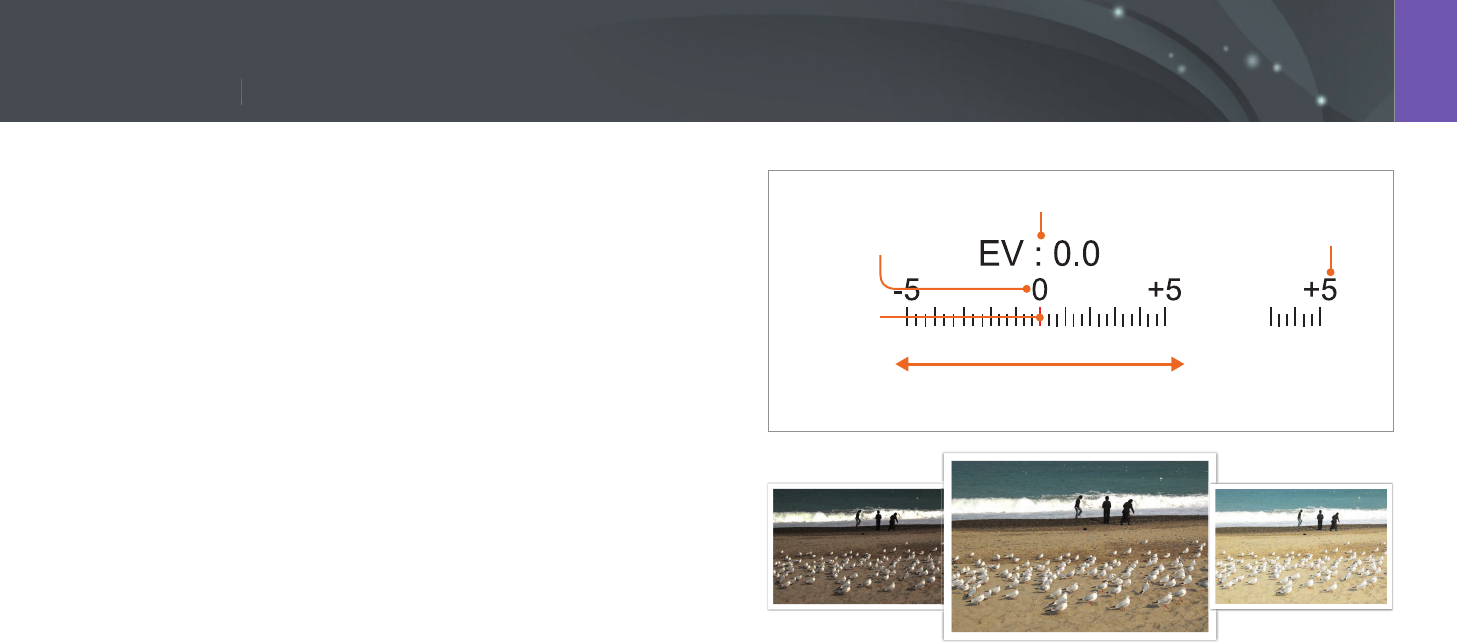
118
Shooting Functions > Exposure compensation
118
Shooting Functions >
Exposure compensation
Shooting Functions
The camera automatically sets the exposure by measuring the levels of
light from the photo’s composition and the position of a subject. If the
exposure set by the camera is higher or lower than you expected, you can
adjust the exposure value manually. The exposure value is adjustable in ±5
increments. The camera displays the exposure warning in red for each step
beyond ±5 range.
To adjust the exposure value, while holding down [B], scroll command
dial 1 or 2. You can also adjust the exposure value by pressing [f], and
then selecting EV.
Exposure level
indicator
Standard exposure index
Increased exposure
(brighter)
Decreased exposure
(darker)
Exposure warning
Exposure adjustment value
-2
Original
+2
Exposure compensation

119
Shooting Functions > Exposure compensation
Using Framing Mode
When you adjust the aperture value or shutter speed, the exposure
changes according to the settings, so the display may darken. With this
function on, the brightness of the display is constant regardless of the
settings, so you can better frame your shot.
To use Framing
Mode,
In Shooting mode, press [m]
→
b
→
Framing Mode
→
an option.
Viewing the overexposure guide
View overexposed areas on a photo in Shooting mode before capturing a
photo. Setting this feature will allow the overexposed areas of a photo to
blink.
To view the
overexposure
guide,
In Shooting mode, press [m]
→
b
→
Overexposure
Guide
→
an option.
Using the brightness adjustment guide
Adjust the brightness using the selected area as a reference.
To adjust the
brightness,
In Shooting mode, press [m]
→
b
→
Brightness Adjust
Guide
→
On
→
select the reference area
→
adjust the
brightness.
•
This feature is available only in Program, Aperture priority, or Shutter priority
mode.
•
This feature cannot be set with the overexposure guide at the same time.
•
This feature cannot be set with the Dynamic Range HDR option at the same
time.
•
This feature cannot be set with ash options at the same time.
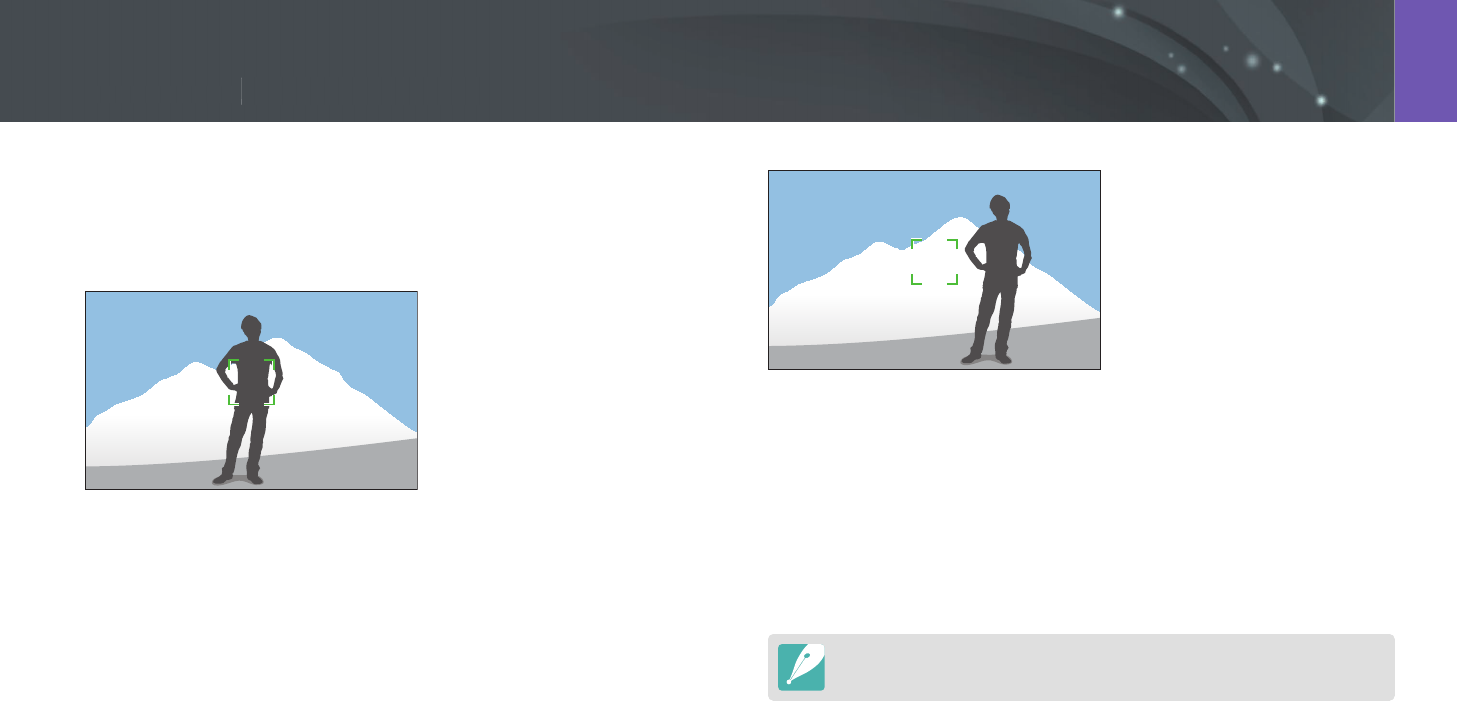
120
Shooting Functions > Exposure/Focus lock
120
Shooting Functions >
Exposure/Focus lock
Shooting Functions
When you cannot achieve an appropriate exposure because of a strong
brightness contrast or you want to capture a photo on which the subject
is out of the auto focus area, lock the focus or exposure and then capture a
photo.
For example, to take a photo with the focus locked, set the focus frame to
where you want to and press the [Shutter] halfway to focus. Then, press
[a] to lock the focus.
After locking the focus and changing to a desired composition, measure
the exposure by pressing [Shutter] halfway, and then press [Shutter] to
take a photo.
To take a photo with the exposure locked, set the focus frame to where
you want to and press the [Shutter] halfway to measure the exposure.
After locking the exposure by pressing [a] and changing to a desired
composition, press the [Shutter] halfway to focus.
You can change the function assigned to the button to focus lock, exposure
lock, or both of them. (p. 174)
Exposure/Focus lock
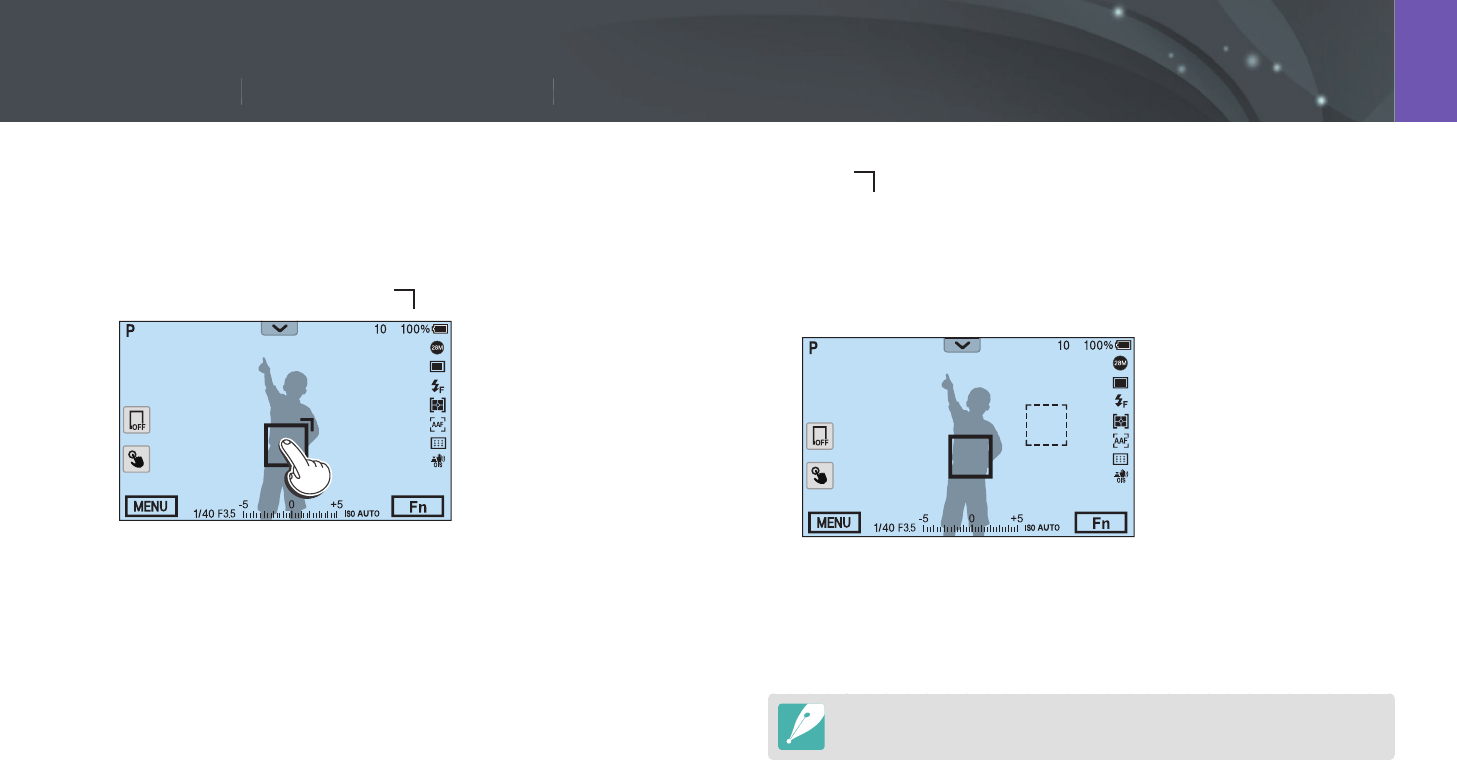
121
Shooting Functions > Exposure/Focus separation
121
Shooting Functions >
Exposure/Focus separation
Shooting Functions
Separate the exposure area and the focus area or merge them again. This
feature is available only when Touch AF is set to Touch AF.
1 On the screen, touch an area to focus on it.
•
The exposure separation icon will appear on the focus frame.
2 Drag to the exposure area.
•
The focus area and the exposure area will be separated.
•
Touch and hold each area to lock the focus or exposure setting.
•
Drag the areas together to merge the focus area and the exposure
area.
Exposure
Focus
3 Press [Shutter] to capture the photo.
•
The focus area and the exposure area will return to their pre-
shooting position.
If you press [a] while its function is set to AEL Hold, the exposure/focus will
not be separated.
Exposure/Focus separation

122
Shooting Functions > Video functions
122
Shooting Functions >
Video functions
Shooting Functions
The functions available for video are explained below.
Movie size
Set the movie size.
To set movie size
options,
In Shooting mode, press [m]
→
g
→
Movie Size
→
an option.
* Default
Icon Size Recommended for
4096X2160 (24 fps) (1.9:1) View on a 4K UHDTV.
3840X2160 (30 fps) (16:9 ) View on a 4K UHDTV.
*1920X1080 (60 fps) (16:9)
View on a Full HDTV. (Videos
recorded with this option may
not play on some HDTVs or smart
phones that do not support 60 fps.)
1920X1080 (30 fps) (16:9) View on a Full HDTV.
1920X1080 (24 fps) (16:9) View on a Full HDTV.
1920X1080 (15 fps) (16:9) View on a Full HDTV. (Available only
with some Smart Filter options.)
1280X720 (60 fps) (16:9) View on an HDTV.
1280X720 (30 fps) (16:9) View on an HDTV.
640X480 (60 fps) (4:3) View on a TV.
640X480 (30 fps) (4:3) View on a TV.
Video functions
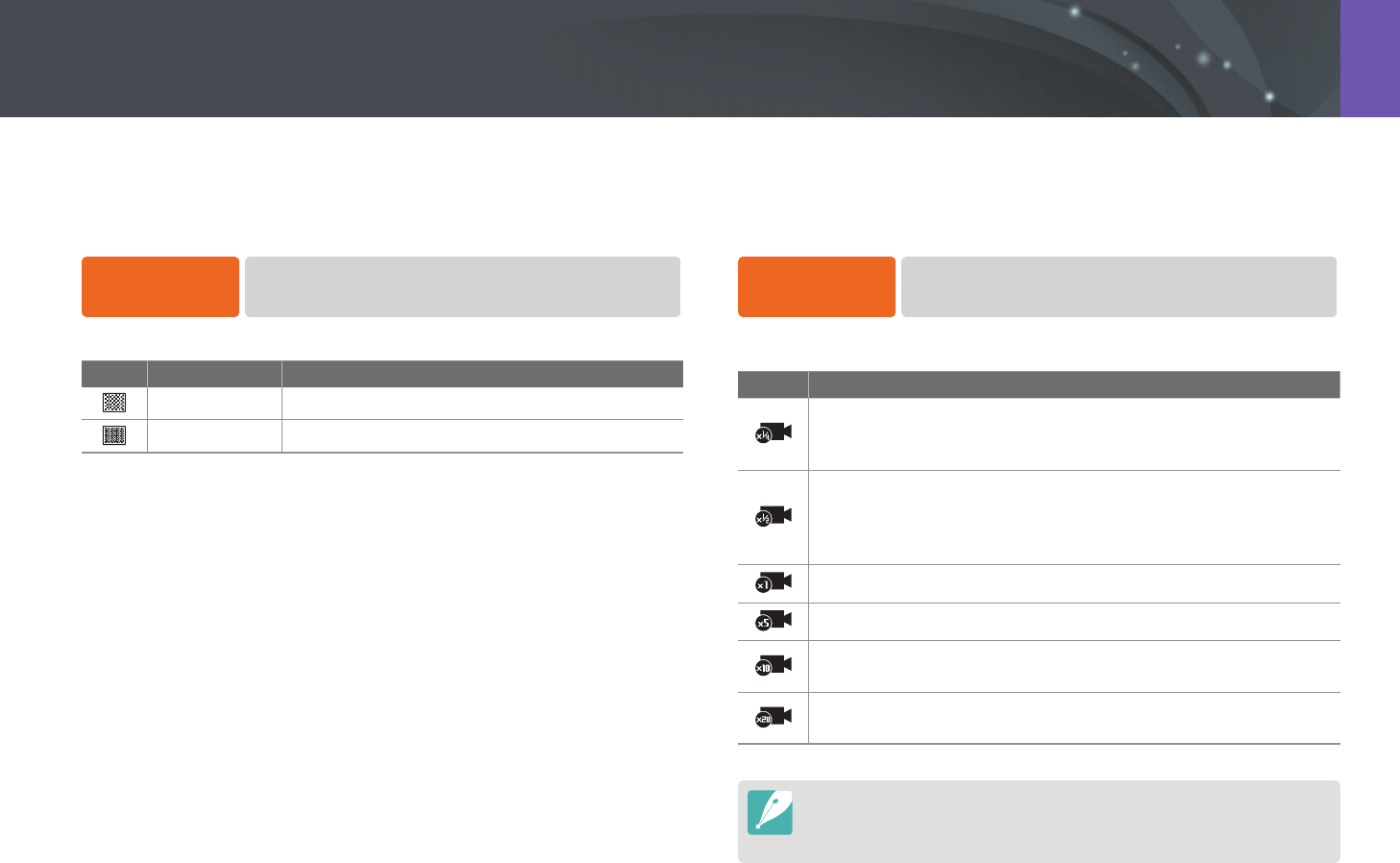
123
Shooting Functions > Video functions
Movie quality
Set the Movie quality.
To set movie
quality options,
In Shooting mode, press [m]
→
g
→
Movie Quality
→
an option.
* Default
Icon Extension Description
HEVC Normal: Record videos in normal quality.
HEVC HQ*: Record videos in high quality.
Multi Motion
Set the playing speed of a video.
To set playing
speed options,
In Shooting mode, press [m]
→
g
→
Multi Motion
→
an option.
* Default
Icon Description
x0.25: Record a video to view it at 1/4 normal speed during
playback. Available only with 1920X1080 (30 fps),
1280X720 (30 fps), 640X480 (30 fps).
x0.5: Record a video to view it at 1/2 normal speed during
playback. Available only with 1920X1080 (60 fps), 1920X1080
(30 fps), 1280X720 (60 fps), 1280X720 (30 fps), 640X480 (60 fps),
640X480 (30 fps).
x1*: Record a video to view it at normal speed during playback.
x5: Record a video to view it at 5X normal speed during playback.
x10: Record a video to view it at 10X normal speed during
playback.
x20: Record a video to view it at 20X normal speed during
playback.
•
If you select an option other than x1, the sound recording function and the
Distortion Correct function will not be supported.
•
The available options may dier depending on shooting conditions.
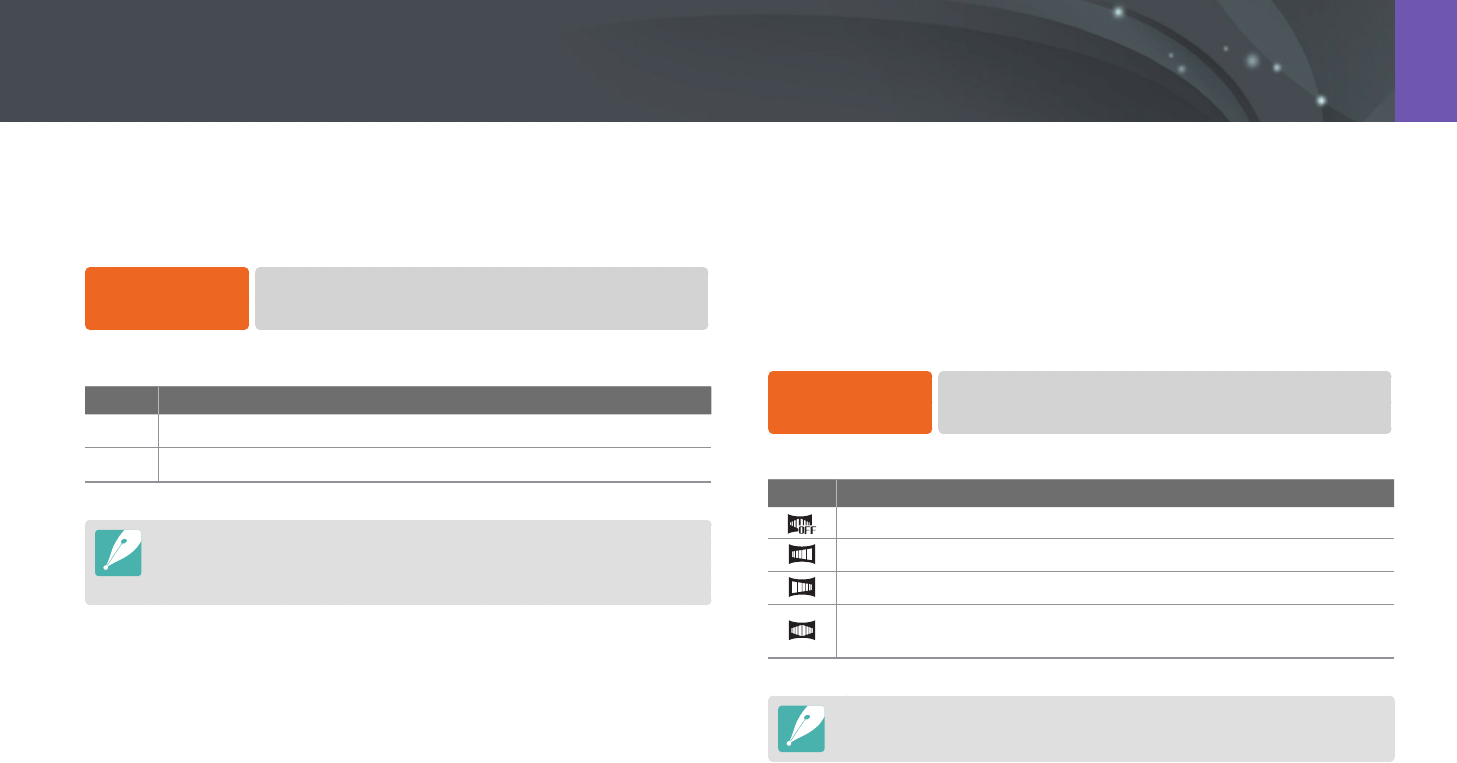
124
Shooting Functions > Video functions
Fader
You can fade in or fade out a scene using the fader function on the camera
without having to do it on a PC. Set the fade in option to gradually fade in
at the start of the scene. Set the fade out option to gradually fade out the
scene. Use the function appropriately and add dramatic eects on your
videos.
To set fader
options,
In Shooting mode, press [m]
→
g
→
Fader
→
an option.
* Default
Icon Description
O*: Fader function not used.
In: Scene gradually fades in.
Out: Scene gradually fades out.
In-Out: The fader function is applied at the start and end of the
scene.
When you use the fader function, it may take longer to save a le.
DIS (Anti-Shake)
Set the Digital Image Stabilization function.
To set the DIS
function,
In Shooting mode, press [m]
→
g
→
DIS (Anti-Shake)
→
an option.
* Default
Option Description
O*
Do not use the DIS function.
On
Use the DIS function.
•
If you record a video with the DIS function, the video will be recorded at a
narrower angle than the lens’ angle.
•
The DIS function is not supported when you attach a sh-eye lens.

125
Shooting Functions > Video functions
Voice
Sometimes, a muted video is more appealing than the one with sound.
Turn the voice o to record a muted video.
To set voice
options,
In Shooting mode, press [m]
→
g
→
Voice
→
an option.
Wind Cut
When you record videos in noisy environments, unintended sounds can
be recorded in videos. In particular, severe wind noise recorded in videos
distracts you from enjoying your videos. Use the Wind Cut function to
remove some surrounding noise in addition to wind noise.
To reduce wind
sound,
In Shooting mode, press [m]
→
g
→
Wind Cut
→
an option.
Mic Level
Set the mic level for the shooting conditions.
To set the mic
level,
In Shooting mode, press [m]
→
g
→
Mic Level
→
rotate
the navigation button or press [e/e] to adjust the mic level
→
touch Set.
Smart Range
Correct the loss of bright detail.
To set Smart Range
options,
In Shooting mode, press [m]
→
g
→
Smart Range
→
an
option.

Chapter 3
Playback/Editing
Learn about how to play back and edit photos and videos.
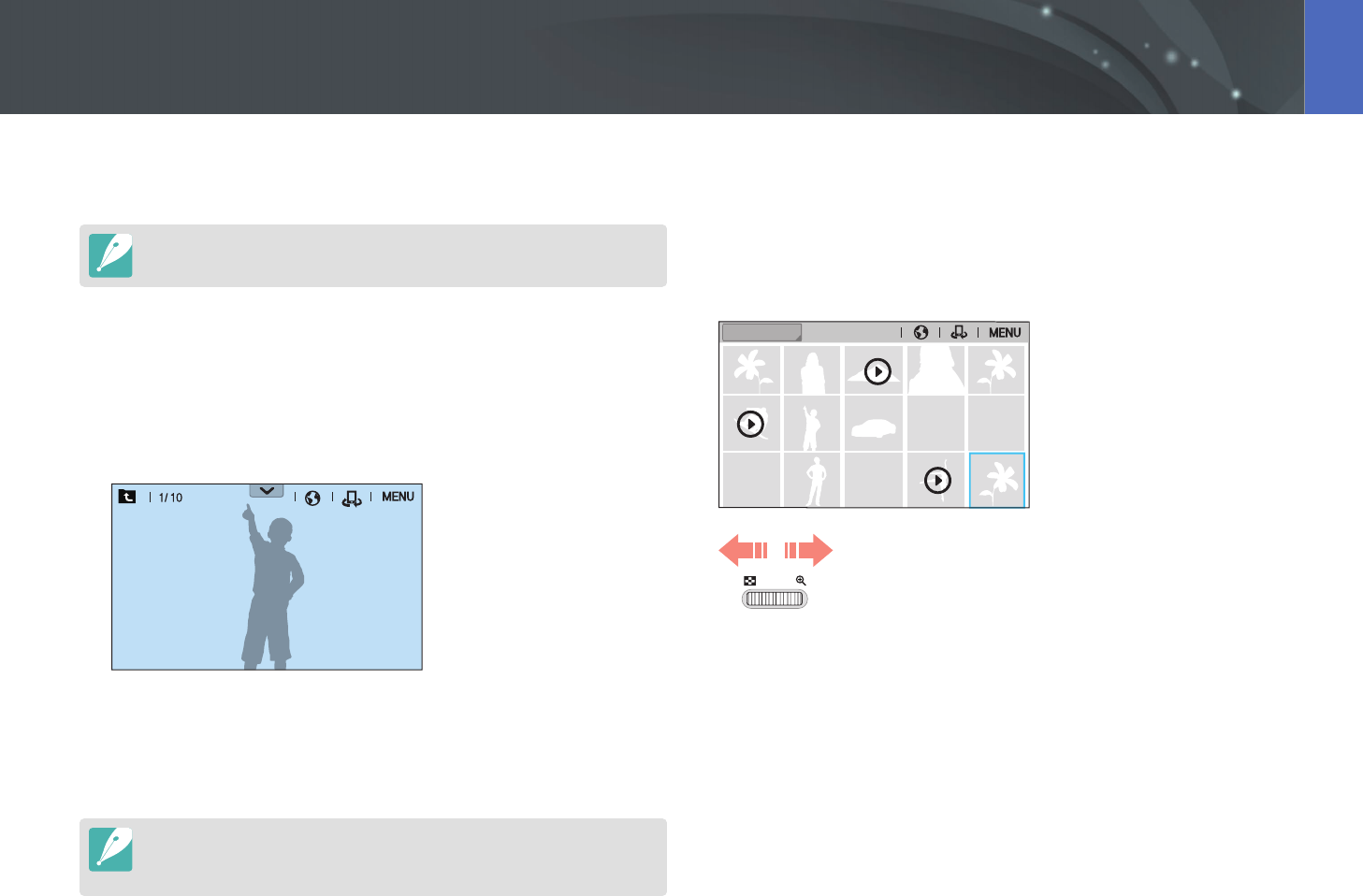
127
Playback/Editing
Learn how to view photo and video thumbnails and how to protect or
delete les.
If you perform no operations for a while, information and icons on the screen
disappear. When you press a button or touch the screen, they will reappear.
Viewing photos
1 Press [y].
•
The most recent le you captured will be displayed.
2 Scroll the command dial 2 or rotate the navigation button or
press [e/e] to scroll through les.
•
You can also drag the image left or right to move to another le.
You may not be able to edit or play back les that were captured with other
cameras, due to unsupported sizes or codecs. Use a computer or another device
to edit or play back these les.
Viewing image thumbnails
In order to search for photos and videos you want, convert to the
thumbnail view. The thumbnail view displays multiple images at a time
so that you can easily look through items you wish to nd. You can also
classify and display les by category, such as date or le type.
All
Scroll the command dial 1 to the left to select the
thumbnail view mode.
(Scroll the command dial 1 to the right to return to the
previous mode.)
Searching and managing files

128
Playback/Editing > Searching and managing les
Viewing les by category
1 In the thumbnail view, press [m]
→
z
→
Filter
→
a category.
•
You can also touch the current category name to open the option
list.
* Default
Option Description
All*
View les normally.
Date
View les by the date they were saved.
Type
View les by the le type.
2 Select a list to open it.
3 Select a le to view it.
4 Touch to return to the previous view.

129
Playback/Editing > Searching and managing les
Viewing les as a folder
Continuous shots appear as a folder. Selecting a folder will play back all
photos automatically. Deleting a folder will delete all photos in the folder.
1 In Playback mode, scroll the command dial 2 or rotate the
navigation button or press [e/e] to move to a desired folder.
•
You can also drag the image left or right to move to a desired folder.
•
The camera will automatically play back photos in the folder.
2 Scroll the command dial 1 to the right to open the folder.
•
You can also touch the folder on the screen or press [o] to open the
folder.
3 Scroll the command dial 2 or rotate the navigation button or
press [e/e] to move to another le.
•
You can also drag the image left or right to move to another le.
4 Scroll the command dial 1 to the left or press [o] to return to
Playback mode.
•
You can also touch to return to Playback mode.

130
Playback/Editing > Searching and managing les
Protecting les
Protect your les from accidental deletion.
1 In Playback mode, press [m]
→
z
→
Protect
→
Multiple
Protect.
2 Scroll the command dial 2 or rotate the navigation button
or press [e/e] to move to a le, and then select the le by
pressing [o].
3 Press .
•
You cannot delete or rotate a protected le.
•
You can directly protect a le in Playback mode by selecting a le, and then
pressing [ ]. To unprotect the le, press [ ] again.
•
For photos that are saved as a folder, press [ ] while the folder is selected to
protect all les.
Lock/Unlock all les
Lock or unlock all les.
1 In Playback mode, press [m]
→
z
→
Protect
→
Protect All.
2 Select an option.
Option Description
Cancel
Return to the previous menu.
Unlock
Unlock all les.
Lock
Lock all les.

131
Playback/Editing > Searching and managing les
Deleting les
Delete les in Playback mode and secure more space on your memory
card. Protected les are not deleted.
Deleting a single le
You can select a single le and delete it.
1 In Playback mode, select a le, and then press [n].
2 When the pop-up message appears, select Ye s.
Deleting multiple les
You can select multiple les and delete them.
1 In Playback mode, press [m]
→
z
→
Delete
→
Multiple
Delete.
•
In thumbnails view, press [m]
→
z
→
Select Item.
•
Alternatively, in thumbnails view, press [n], and then select les to
delete.
2 Scroll the command dial 2 or rotate the navigation button
or press [e/e] to move to a le, and then select the le by
pressing [o].
•
Press [o] again to cancel your selection.
3 Press [n].
4 When the pop-up message appears, select Ye s.
Deleting all les
You can delete all les on the memory card at once.
1 In Playback mode, press [m].
2 Select z
→
Delete
→
Delete All.
3 When the pop-up message appears, select Ye s.

132
Playback/Editing
Enlarging a photo
You can enlarge photos when viewing them in Playback mode. You can
also use the Trim function to extract the portion of the image displayed on
the screen and save it as a new le.
Magnied area
Magnication (The maximum
magnication may dier by
resolution.)
Full Image Crop
Scroll the command dial 1 to the right to enlarge a photo.
(Scroll the command dial 1 to the left to reduce a photo.)
To Do this
Move magnied area
Press [D/h/e/e].
Crop the enlarged image
Press [f]. (saved as a new le)
Return to the original image
Press [o].
•
You can also pinch your ngers together or spread them apart on the screen
to reduce or enlarge a photo. You can also double-tap an area to enlarge it
quickly.
•
You can scroll through les by rotating the navigation button, even when a
photo is enlarged.
Viewing photos

133
Playback/Editing > Viewing photos
Viewing a slide show
You can view photos in a slide show and apply various eects.
1 In Playback mode, press [m].
2 Select z
→
Slide Show Options.
3 Select a slide show eect option.
•
Skip to step 4 to start a slide show with no eects.
* Default
Option Description
Play Mode
Set whether or not to repeat the slide show.
(One Play*, Repeat)
Interval
Set the interval between photos. (1 sec*, 3 sec, 5 sec,
10 sec)
Eect
• Set a scene change eect between photos.
• Select O to cancel eects.
4 Press [m].
5 Select Start Slide Show.
6 View the slide show.
•
Press [o] to pause.
•
Press [o] again to resume.
•
Press [m] to stop the slide show and return to Playback mode.

134
Playback/Editing > Viewing photos
Viewing the overexposure guide
Set the overexposed areas of a photo to blink.
To view the
overexposure guide,
In Playback mode, press [m]
→
z
→
Overexposure
Guide
→
an option.
Viewing interval shots
View photos that are captured with the Interval Capture function.
To view interval
shots,
In Playback mode, press [m]
→
z
→
Play Interval Shots.
Auto rotating
With Auto Rotate on, the camera automatically rotates photos you have
captured vertically so they t the screen horizontally.
To set auto rotate
options,
In Playback mode, press [m]
→
z
→
Auto Rotate
→
an
option.
Converting to JPEG
Convert RAW les to JPG les.
To convert les,
In Playback mode, press [m]
→
z
→
Convert to JPG.
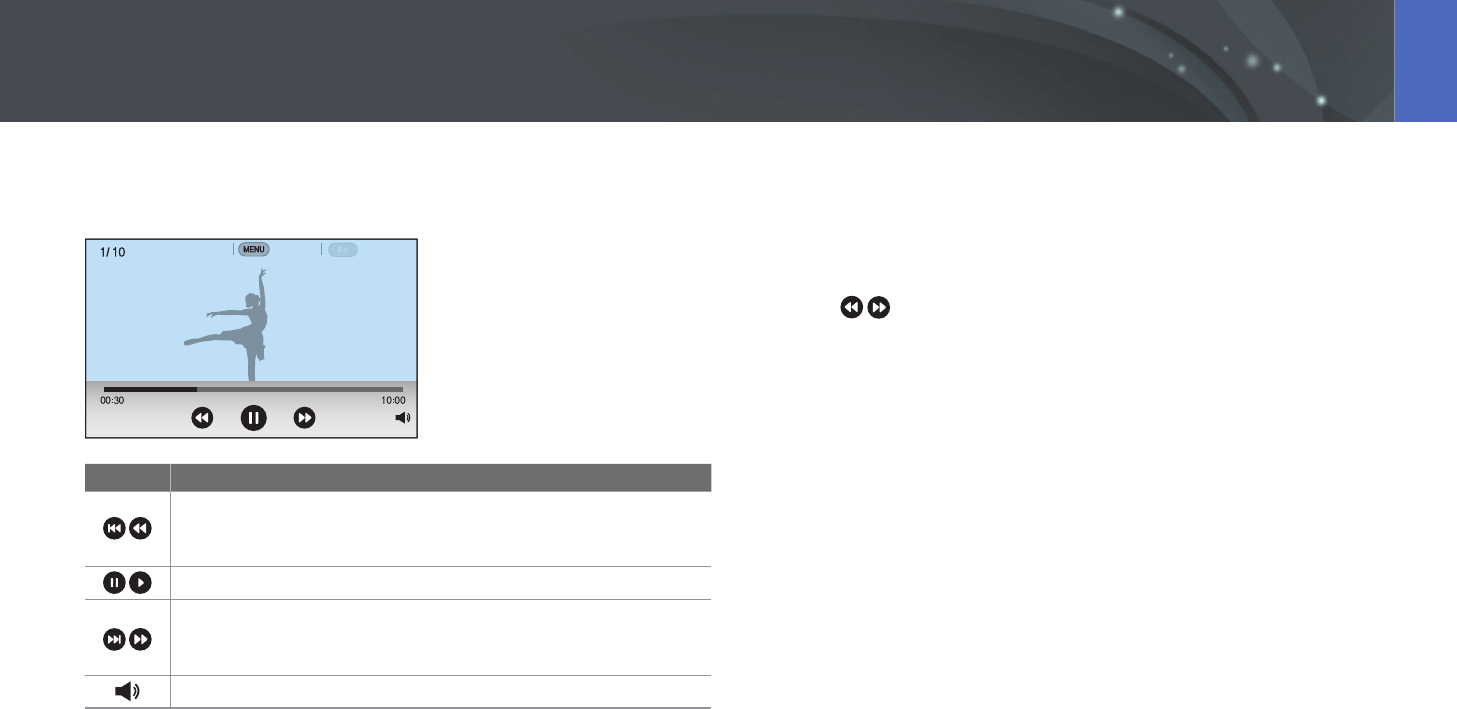
135
Playback/Editing
In Playback mode, you can play a video, capture an image from a video, or
crop a video to save as another le.
Stop
Capture
Icon Description
View previous le/Scan backward. (Each time you touch the icon
while playing the video, you change the scan speed in this order:
2X, 4X, 8X.)
Pause or resume playback.
View next le/Scan forward. (Each time you touch the icon while
playing the video, you change the scan speed in this order: 2X,
4X, 8X.)
Adjust the volume or mute the sound.
Scanning backward or forward
To scan backwards or forwards through a video le while it is playing, use
one of the following methods.
•
Touch . Each time you touch the icon, you change the scan speed
in this order: 2X, 4X, 8X.
•
Press [e/e]. Each time you press the button, you change the scan speed
in this order: 2X, 4X, 8X.
•
Scroll the command dial 1 to the left or right. Each time you scroll the
command dial 1, you change the scan speed in this order: 2X, 4X, 8X.
•
Drag the handles that appear on the progress bar to the left or right. You
can change the playback position in the video.
Playing videos
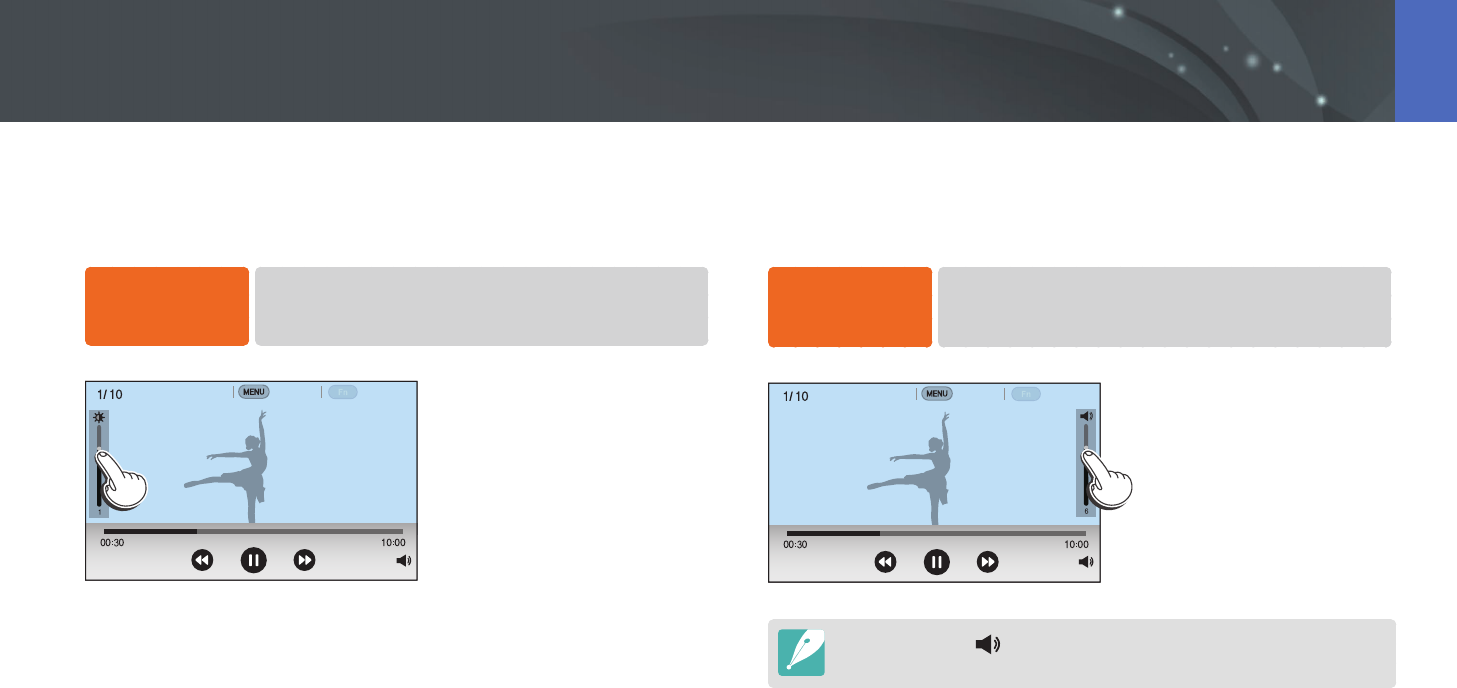
136
Playback/Editing > Playing videos
Adjusting the brightness of a video
Adjust the brightness of a video while playing it.
To adjust the
brightness of a
video,
Touch the left half of the display
→
drag upward or downward.
Stop
Capture
Adjusting the volume of a video
Adjust the volume of a video while playing it.
To adjust the
volume of a video,
Touch the right half of the display
→
drag upward or
downward.
Stop
Capture
You can also touch and drag the slider on the volume control bar upward or
downward.

137
Playback/Editing > Playing videos
10
When the pop-up message appears, select Ye s.
•
You cannot trim a video recorded in 3D mode.
•
The original video should be at least 10 seconds long.
•
The camera will save the edited video as a new le and leave the original
video intact.
Capturing an image during playback
1 While viewing a video, press [o] or touch at the point
where you want to capture an image.
2 Press [f] or touch Capture.
•
You cannot capture an image from a video recorded in 3D mode.
•
The resolution of the captured image will be the same as the original video.
•
The captured image is saved as a new le.
Trimming a video during playback
1 In Playback mode, scroll to a video, and then press [m].
2 Select Trim Movie.
3 Press [o] or touch to start playing the video.
4 Press [o] or touch at the point where you want the
trimming to begin.
5 Press [f] or touch Start Point.
6 Press [o] or touch to resume playing the video.
7 Press [o] or touch at the point where you want the
trimming to end.
8 Press [f] or touch End Point.
9 Press [f] or touch Trim to trim a video.
•
You can adjust the scene to be cropped by dragging the handles
that appear on the progress bar.

138
Playback/Editing
Perform photo editing tasks, such as resizing or rotating. Edited photos
are saved as new les under dierent le names. Photos captured in some
modes cannot be edited with the Image Edit function.
To edit images,
In Playback mode, scroll to a photo, and then press [f]
→
an option.
•
You can also edit images in Playback mode by selecting a photo, and then
pressing [m]
→
z
→
Edit Image.
•
Some images may not be edited with the Edit Image function. In this case, use
the supplied image editing software.
•
The camera will save edited photos as new les.
•
When you edit photos, the camera will automatically convert them to a lower
resolution. Photos that you rotate or resize manually are not automatically
converted to a lower resolution.
•
You cannot edit photos while viewing les as a folder. Open the folder and
select a photo to edit each photo.
Cropping a photo
1 Touch
→
.
2 Drag the sides of the box to adjust the size of the area.
3 Drag the box to move the location of the area.
4 Press [o] or touch Done.
5 Touch to save.
Editing photos
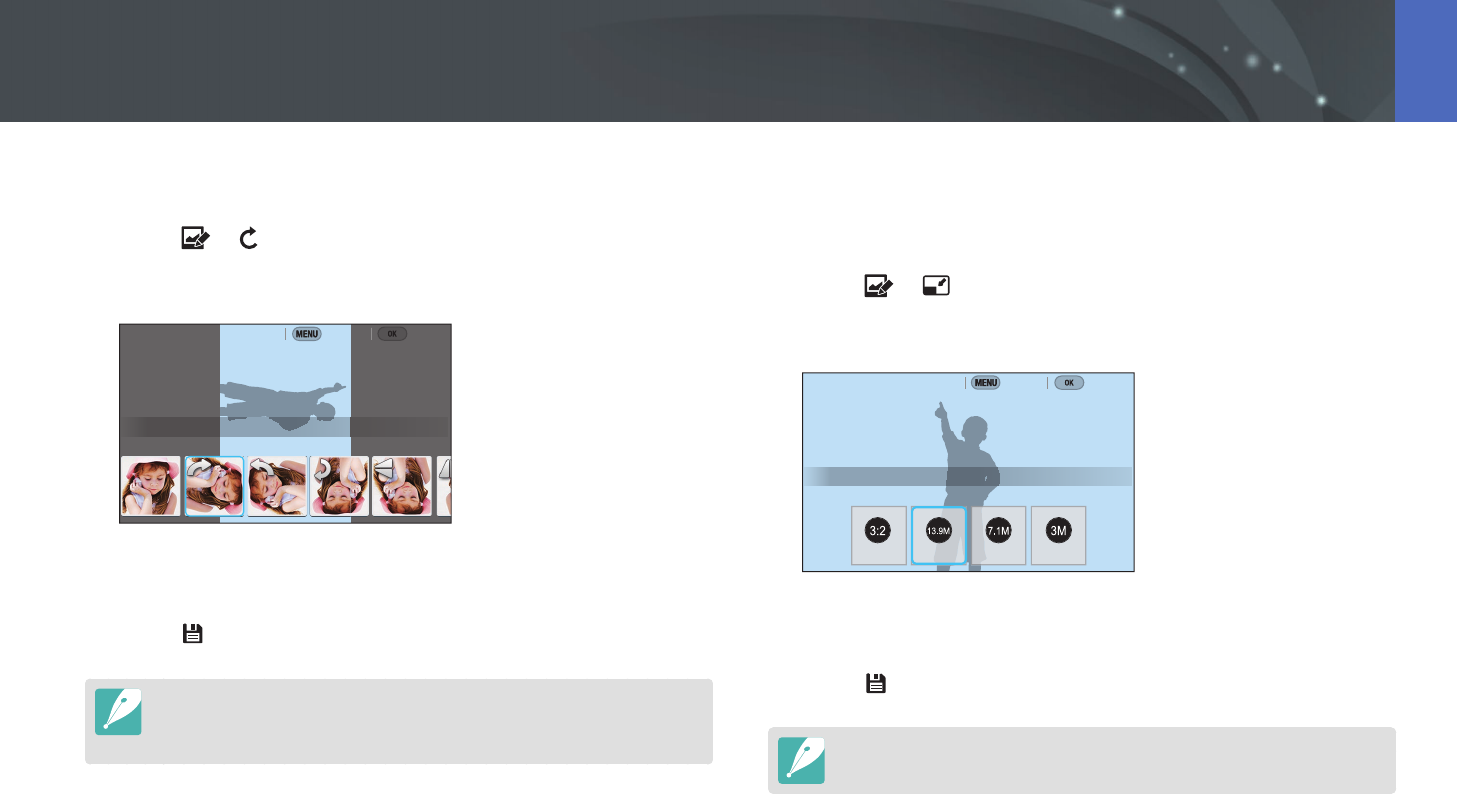
139
Playback/Editing > Editing photos
Rotating a photo
1 Touch
→
.
2 Touch an option.
Rotate : Right 90˚
Cancel Done
3 Press [o] or touch Done.
4 Touch to save.
•
You can also rotate a photo in Playback mode by pressing [m], and then
selecting z
→
Rotate
→
a desired option.
•
The camera will overwrite the original le.
Resizing photos
Change the size of a photo and save it as a new le.
1 Touch
→
.
2 Touch an option.
Resize : 13.9M 3:2
Cancel Done
3 Press [o] or touch Done.
4 Touch to save.
Available resize options dier depending on the original size of the photo.
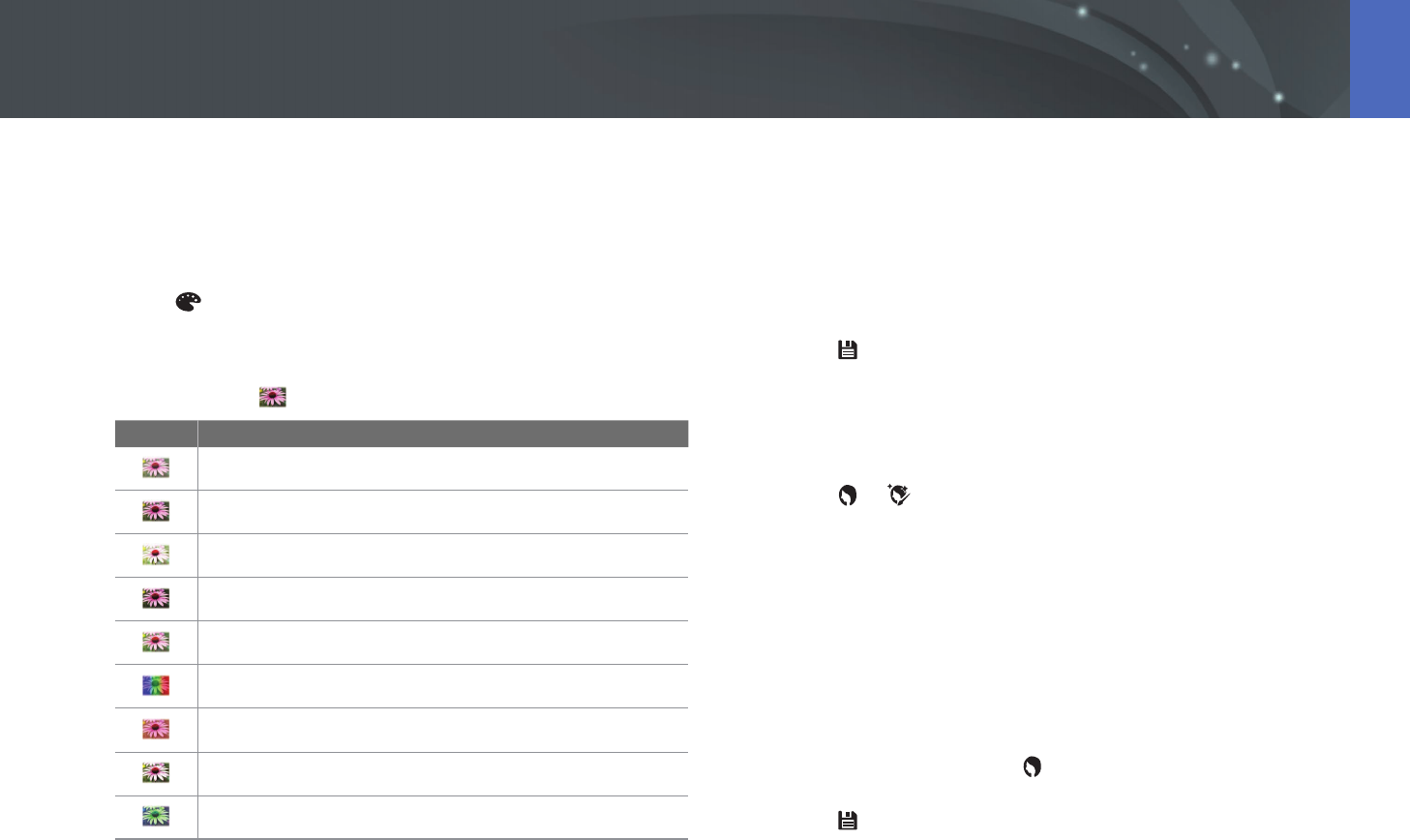
140
Playback/Editing > Editing photos
Adjusting your photos
You can correct captured photos by adjusting the brightness, contrast, or
color.
1 Touch .
2 Touch an adjusting option.
•
If you selected (Auto adjustment), skip to step 4.
Icon Description
Original (Reset to the original image.)
Auto adjustment
Brightness
Contrast
Saturation
RGB adjustment
Color Temperature
Exposure
Hue
3 Scroll the command dial 1 or rotate the navigation button or
press [e/e] to adjust the option.
•
You can also drag the slider or touch +/- to adjust the option.
4 Press [o] or touch Done.
5 Touch to save.
Retouching faces
1 Touch
→
.
2 Scroll the command dial 1 or rotate the navigation button or
press [e/e] to adjust the option.
•
You can also drag the slider or touch +/- to adjust the option.
•
As the number increases, the skin tone becomes brighter and
smoother.
3 Press [o] or touch Done.
•
To cancel correction, touch .
4 Touch to save.
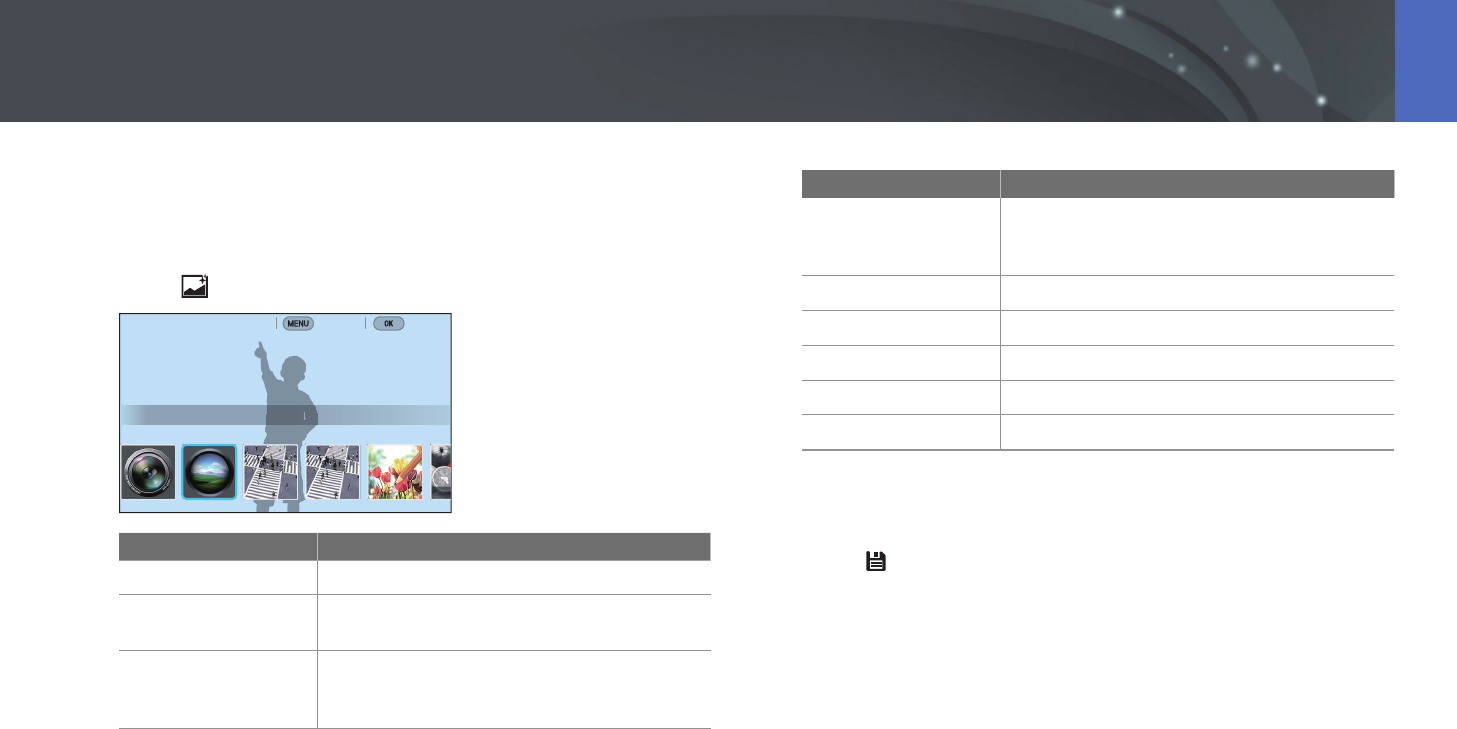
141
Playback/Editing > Editing photos
Applying Smart Filter eects
Apply special eects to your photos.
1 Touch , and then touch an option.
Smart Filter : Vignetting
Cancel Done
Option Description
Original
No eect
Vignetting
Apply the retro-looking colors, high contrast,
and strong vignette eect of Lomo cameras.
Miniature (H)
Apply a tilt-shift eect to make the subject
appear in miniature. The top and bottom of
the photo will be blurred.
Option Description
Miniature (V)
Apply a tilt-shift eect to make the subject
appear in miniature. The left and right of the
photo will be blurred.
Watercolor
Apply a watercolor painting eect.
Red
Desaturate all colors but red.
Green
Desaturate all colors but green.
Blue
Desaturate all colors but blue.
Yellow
Desaturate all colors but yellow.
2 Press [o] or touch Done.
3 Touch to save.

Chapter 4
Connecting & Transferring
Learn how to share photos or videos and use various features.

143
Connecting & Transferring
Connecting to a smart phone
Using NFC features in Playback mode (Photo Beam)
In Playback mode, the camera transfers the current les to the smart
phone automatically by placing the two devices close to each other while
they are connected via Bluetooth.
•
To transfer multiple les, select les from the thumbnail view, and then
read a tag from an NFC-enabled device.
Using the NFC Feature
Place a smart phone’s NFC antenna near the camera’s NFC tag to connect
the camera to the smart phone. You can also transfer les to an NFC-
enabled device in Playback mode.
•
This feature is supported by NFC-enabled smart phones running Android OS.
It is recommended that you use the latest version. This feature is not available
for iOS devices.
•
You should install Samsung Camera Manager on your phone or device before
using this feature. You can download the application from GALAXY Apps
or the Google Play Store. Samsung Camera Manager is compatible with
Samsung camera NX1 or later and is supported by Android OS 4.1 or higher.
•
To read an NFC tag, place the NFC-enabled device near the camera’s NFC tag
for more than 2 seconds.
•
You can set the size for transferred photos by pressing [m], and then
selecting d
→
MobileLink/NFC Image Size
→
an option.
•
Do not modify the NFC tag in any way.
Using NFC features in Shooting mode
Launch MobileLink, Remote Viewnder or Quick Transfer by reading a tag
from an NFC-enabled device to connect the camera and a smart phone,
and then pressing [R]. (p. 144, 146, 148)

144
Connecting & Transferring > Connecting to a smart phone
Sending les to a smart phone
The camera connects to a smart phone that supports the MobileLink
feature via Bluetooth or Wi-Fi. You can easily send photos or videos to your
smart phone.
•
The MobileLink feature is supported by smart phones or tablets running
Android OS or iOS. (Some features may not be supported by some models.)
Before using this feature, update the device’s rmware to the latest version.
If the rmware version is not the most recent, this function may not perform
properly.
•
You should install Samsung Camera Manager on your phone or device before
using this feature. You can download the application from GALAXY Apps
or the Google Play Store. Samsung Camera Manager is compatible with
Samsung camera NX1 or later and is supported by Android OS 4.1 or higher.
•
When there are no les in the camera memory, you cannot use this feature.
•
You can view up to 1,000 recent les and send up to 1,000 les at a time.
•
When you send Full HD or UHD videos using the MobileLink feature, you
may not be able to play back les on some devices that are not supported by
HEVC codecs.
•
When using this feature on an iOS device, the device may lose its Wi-Fi
connection.
•
You cannot send RAW les.
•
You can set the size for transferred photos by pressing [m], and then
selecting d
→
MobileLink/NFC Image Size
→
an option.
•
You can only connect to Android OS devices that support the Bluetooth
feature. You cannot connect to Bluetooth speakers, headsets, or other
accessories.
•
The screen turns o if you perform no operations on the camera for 30
seconds.
1 In Shooting mode, press [R].
•
You can also press and hold [R] to launch the MobileLink feature
directly.
2 Touch .
•
If the pop-up message that prompts you to download the
application appears, select Next.
•
To require PIN verication when connecting the smart phone to the
camera, select Security Settings. (p. 180)
•
If the pop-up message that prompts you to set the auto time
setting appears, select Yes to sync the camera’s date and time to
the smart phone’s. (p. 180)
3 On the smart phone, turn on Samsung Camera Manager.
•
Ensure that Bluetooth and Wi-Fi are enabled on the camera and the
smart phone before turning on the application.
•
To start the application automatically on an NFC-enabled smart
phone, turn on the function and place the smart phone near
the NFC tag (p. 34) on the camera. Verify that the smart phone is
connected to your camera, and then skip to step 7.

145
Connecting & Transferring > Connecting to a smart phone
4 Select the camera from the smart phone and connect.
•
The smart phone can connect to only one camera at a time.
•
If the Wi-Fi Privacy lock is enabled and Wi-Fi is connected, enter the
PIN displayed on the camera to the smart phone.
5 On the camera, allow the smart phone to connect to your
camera or conrm the registration request.
•
If the smart phone has been connected to your camera before, it is
connected automatically.
6 Select les to transfer.
7 On the smart phone, touch the copy button.
•
The camera will send the les to the smart phone.

146
Connecting & Transferring > Connecting to a smart phone
Using a smart phone as a remote shutter
release
The camera connects to a smart phone that supports the Remote
Viewnder feature via Bluetooth or Wi-Fi. Use the smart phone as a remote
shutter release with the Remote Viewnder feature.
•
The Remote Viewnder feature is supported by smart phones or tablets
running Android OS or iOS. (Some features may not be supported by some
models.) Before using this feature, update the device’s rmware to the latest
version. If the rmware version is not the most recent, this function may not
perform properly.
•
You should install Samsung Camera Manager on your phone or device before
using this feature. You can download the application from GALAXY Apps
or the Google Play Store. Samsung Camera Manager is compatible with
Samsung camera NX1 or later and is supported by Android OS 4.1 or higher.
•
This function is not available when you attach a 3D lens in 3D mode.
•
You can only connect to Android OS devices that support the Bluetooth
feature. You cannot connect to Bluetooth speakers, headsets, or other
accessories.
1 In Shooting mode, press [R].
•
If the pop-up message that prompts you to select the device to
connect appears, select the type of your smart phone.
2 Touch .
•
If the pop-up message that prompts you to download the
application appears, select Next.
•
To require PIN verication when connecting the smart phone to the
camera, select Security Settings. (p. 180)
•
If the pop-up message that prompts you to set the auto time
setting appears, select Yes to sync the camera’s date and time to
the smart phone’s. (p. 180)
3 On the smart phone, turn on Samsung Camera Manager.
•
Ensure that Bluetooth and Wi-Fi are enabled on the camera and the
smart phone before turning on the application.
•
To start the application automatically on an NFC-enabled smart
phone, turn on the function and place the smart phone near
the NFC tag (p. 34) on the camera. Verify that the smart phone is
connected to your camera, and then skip to step 6.

147
Connecting & Transferring > Connecting to a smart phone
4 Select the camera from the smart phone and connect.
•
The smart phone can connect to only one camera at a time.
•
If the Wi-Fi Privacy lock is enabled and Wi-Fi is connected, enter the
PIN displayed on the camera to the smart phone.
5 On the camera, allow the smart phone to connect to your
camera or conrm the registration request.
•
If the smart phone has been connected to your camera before, it is
connected automatically.
6 On the smart phone, select q to open the smart panel.
7 On the smart phone, set the shooting options.
•
While using this feature, some buttons are not available on your
camera.
•
The zoom button and the shutter button on your smart phone will
not function when using this feature.
•
Some shooting options are not supported.
•
Shooting options that you have set will remain on the camera after
the connection with the smart phone has ended.
8 Touch to return to the shooting screen.
9 On the smart phone, touch and hold to focus, and then
release it to capture the photo.
•
Touch to record a video and touch to stop a video.
•
Touch to view the captured photo and send it to the smart
phone.
•
If the GPS feature is activated on the smart phone, the GPS
information will be saved with the captured photo.
•
When you use this feature, the ideal distance between the camera and the
smart phone may vary, depending on your surroundings.
•
The smart phone must be within 7 m of the camera to use this feature.
•
It will take some time to capture the photo after you release on the
smart phone.
•
The Remote Viewnder function will deactivate when:
-
you answer an incoming call on the iOS devices.
-
there is an incoming call on the smart phone
-
either the camera or the smart phone turns o
-
device loses a Bluetooth or Wi-Fi connection
-
Bluetooth or Wi-Fi connection is poor or unstable
-
you perform no operations for approximately 3 minutes while connected

148
Connecting & Transferring > Connecting to a smart phone
Saving les to a smart phone automatically
The camera connects to a smart phone that supports the Quick Transfer
feature via Bluetooth. When you capture a photo with your camera, the
photo is saved to a smart phone automatically.
•
The Quick Transfer feature is supported by smart phones or tablets running
Android OS or iOS. (Some features may not be supported by some models.)
Before using this feature, update the device’s rmware to the latest version.
If the rmware version is not the most recent, this function may not perform
properly.
•
You should install Samsung Camera Manager on your phone or device before
using this feature. You can download the application from GALAXY Apps
or the Google Play Store. Samsung Camera Manager is compatible with
Samsung camera NX1 or later and is supported by Android OS 4.1 or higher.
•
If you set this function, the setting is maintained even when you change the
Shooting mode.
•
This feature may not be supported in some modes or may not be available
with some shooting options.
•
You can only connect to Android OS devices that support the Bluetooth
feature. You cannot connect to Bluetooth speakers, headsets, or other
accessories.
1 In Shooting mode, touch .
•
You can also press [R], and then select .
•
If the pop-up message that prompts you to download the
application appears, select Next.
•
To require PIN verication when connecting the smart phone to the
camera, select Security Settings. (p. 180)
•
If the pop-up message that prompts you to set the auto time
setting appears, select Yes to sync the camera’s date and time to
the smart phone’s. (p. 180)
2 On the smart phone, turn on Samsung Camera Manager.
•
Ensure that Bluetooth and Wi-Fi are enabled on the camera and the
smart phone before turning on the application.
•
To start the application automatically on an NFC-enabled smart
phone, turn on the function and place the smart phone near
the NFC tag (p. 34) on the camera. Verify that the smart phone is
connected to your camera, and then skip to step 5.
3 Select the camera from the smart phone and connect.
•
The smart phone can connect to only one camera at a time.
•
If the Wi-Fi Privacy lock is enabled and Wi-Fi is connected, enter the
PIN displayed on the camera to the smart phone.

149
Connecting & Transferring > Connecting to a smart phone
4 On the camera, allow the smart phone to connect to your
camera or conrm the registration request.
•
If the smart phone has been connected to your camera before, it is
connected automatically.
•
The Quick Transfer icon on the camera’s screen will be changed to
an icon that shows the connection status ( ).
5 Capture a photo.
•
The captured photo is saved in the original size to the camera, and
then transferred in the size of 2M to the smart phone. If a memory
card is not inserted or the memory is full, the captured photo is
transferred to the smart phone without being saved to the camera.
•
If you captured continuous photos, the rst captured photo is
transferred to the smart phone.
•
If you recorded a video, the preview image of recording is
transferred to the smart phone.
•
The image le captured while recording a video is not saved on the
smart phone.
•
If the GPS feature is activated on the smart phone, the GPS
information will be saved with the captured photo.

150
Connecting & Transferring
Sharing via SNS & email
Upload photos or videos to SNS or send them to other people via email.
Connecting to a WLAN
Learn to connect via an access point (AP) when you are in a range of a
WLAN. You can also congure network settings.
1 In Shooting mode, touch .
2 Select a service from the list.
•
The camera automatically searches for available AP devices.
•
Available services will be displayed on your camera.
•
If a pop-up message about data collection regulations appears,
read and agree to it.
3 Select an AP.
Samsung1
Samsung2
Samsung3
Samsung4
Wi-Fi Setting
Refresh
Back
•
Select Refresh to refresh the list of connectable APs.
•
Select Add wireless network to add an AP manually. The AP name
must be in English to add the AP manually.
Icon Description
Ad hoc AP
Secured AP
WPS AP
Signal strength
Press [F] or touch to open network setting options.
•
When you select a secured AP, a pop-up window appears. Enter the
required passwords to connect to the WLAN. For information about
entering text, refer to “Entering text“. (p. 154)

151
Connecting & Transferring > Sharing via SNS & email
•
When a login page appears, refer to “Using the web browser“.
(p. 152)
•
When you select an unsecured AP, the camera will connect to the
WLAN.
•
If you select a WPS prole supported AP, select
→
WPS PIN
connection, and then enter a PIN on the AP device. You can also
connect to a WPS prole supported AP by selecting
→
WPS
button connection on the camera, and then pushing the WPS
button on the AP device.
•
The same AP may be listed twice, with dierent frequencies,
because your camera supports the dual band function.
Setting network options
1 In the Wi-Fi Setting screen, move to an AP, and then press [e]
or touch .
2 Select each option, and then enter the required information.
Option Description
Network Password
Enter the network password.
IP Setting
Set the IP address automatically or manually.
Manually setting the IP address
1 In the Wi-Fi Setting screen, move to an AP, and then press [e]
or touch .
2 Select IP Setting
→
Manual.
3 Select each option, and then enter the required information.
Option Description
IP
Enter the static IP address.
Subnet Mask
Enter the subnet mask.
Gateway
Enter the gateway.
DNS Server
Enter the DNS address.

152
Connecting & Transferring > Sharing via SNS & email
Using the web browser
Log in to SNS or access websites using the web browser.
Icon Description
Move to Playback mode.
Stop loading the page.
Reload the page.
Move to the previous page.
Move to the next page.
Move to the home page.
Fn
• Wi-Fi Setting: View the Wi-Fi setting screen.
• Bookmarks: Add or delete favorite web sites.
• Remember passwords: Turn on or o the automatic
save function of website passwords.
• Delete personal data: Delete personal data such as
cookies, site data, or password.
• Text scaling: Adjust the text size of a web page.
• Text encoding: Select an option of text encoding of a
web page.
Icon Description
Navigation
button
Scroll a web page by rotating.
Command dial 1
Reduce or enlarge a web page.
•
You may not be able to select some items depending on the page you
connected to. This does not indicate a malfunction.
•
It may take longer to load the login page due to the page size or network
speed. If this occurs, wait until the login information input window appears.

153
Connecting & Transferring > Sharing via SNS & email
Network connection tips
•
You must insert a memory card to use the Wi-Fi features.
•
The quality of the network connection will be determined by the AP.
•
The further the distance between your camera and the AP, the longer it
will take to connect to the network.
•
If a nearby device is using the same radio frequency signal as your
camera, it may interrupt your connection.
•
If your AP name is not in English, the camera may not be able to locate
the device or the name may appear incorrectly.
•
For network settings or a password, contact your network administrator
or network service provider.
•
If a WLAN requires authentication from the service provider, you may not
be able to connect to it. To connect to the WLAN, contact your network
service provider.
•
Depending on the encryption type, the number of digits in the password
may dier.
•
A WLAN connection may not be possible in all surroundings.
•
The camera may display a WLAN enabled printer on the AP List. You
cannot connect to a network via a printer.
•
You cannot connect your camera to a network and a TV simultaneously.
•
Connecting to a network may incur additional charges. Costs will vary
based on the conditions of your contract.
•
If you cannot connect to a WLAN, try another AP from the available AP
list.
•
A login page may appear when you select free WLANs provided by some
network service providers. Enter your ID and password to connect to
the WLAN. For information about registering or the service, contact the
network service providers.
•
Be cautious when you enter personal information for an AP connection.
Do not enter any payment or credit card information on your camera.
The manufacturer is not liable for any problem caused by entering such
information.
•
Available network connections may dier by country.
•
The WLAN feature of your camera must comply with radio transmission
laws in your region. To ensure compliance, use the WLAN feature only in
the country where you purchased the camera.
•
The process for adjusting network settings may dier, depending on
network conditions.
•
Do not access a network that you are not authorized to use.
•
Before you connect to a network, ensure your battery is fully charged.
•
You cannot upload or send les captured in some modes.
•
Files that you transfer to another device may not be supported by the
device. In this case, use a computer to play back the les.
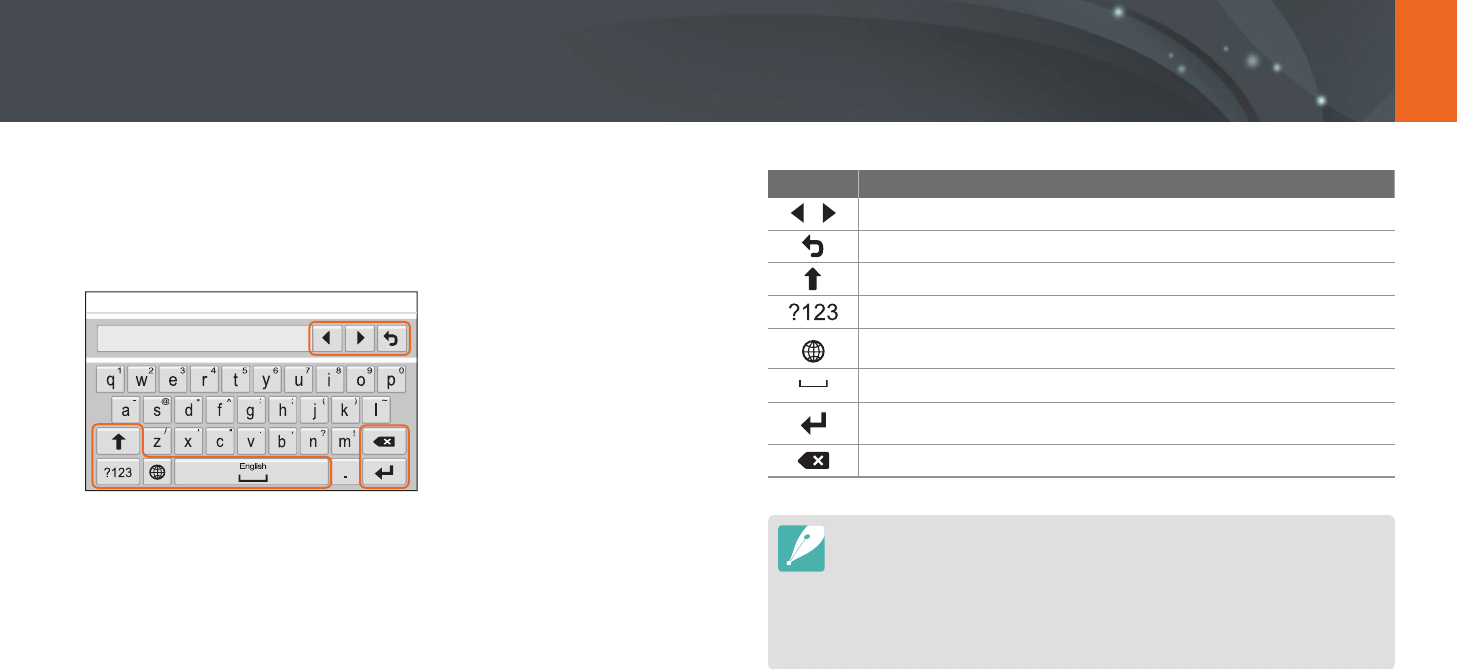
154
Connecting & Transferring > Sharing via SNS & email
Entering text
Learn how to enter text. The icons in the table let you move the cursor,
change the case, etc. Touch a key to enter it.
Icon Description
Move the cursor.
Stop entering text and return to the previous page.
Change case.
Switch between Symbol/Number mode and the normal mode.
Change the input language.
Enter a space.
Save the displayed text.
Delete the last letter.
•
You can use only the English alphabets in some modes, regardless of the
display language.
•
The number of characters you can enter varies depending on the situation.
•
The screen may dier depending on the input mode.
•
Touch and hold a key to enter the character at the upper right corner of the
key.

155
Connecting & Transferring > Sharing via SNS & email
Uploading photos or videos to SNS
Upload your photos or videos to SNS. Available SNS will be displayed on
your camera. To upload les to some SNS, you must visit the website and
register before connecting your camera.
1 In Playback mode, touch .
2 Select a service from the list.
•
If the pop-up message that prompts you to create an account
appears, select OK.
3 Connect to a WLAN. (p. 150)
4 Enter your ID and password to log in.
•
For information about entering text, refer to “Entering text“.
(p. 154)
•
If you connected to some sharing services, refer to “Using the web
browser“. (p. 152)
•
To select an ID from the list, select
→
an ID.
•
If you have previously logged in to the SNS, you may be logged in
automatically.
You must have an existing account on the SNS to use this feature.
5 Select les and upload.
•
Depending on services, the total size or number of les may vary.
•
On some services, you can enter your comments by selecting
the comment box. For information about entering text, refer to
“Entering text“. (p. 154)

156
Connecting & Transferring > Sharing via SNS & email
•
You cannot upload les if the le size exceeds the limit. The maximum
resolution of photos you can upload is 2M. The maximum resolution of videos
you can upload is XX. If the selected photo has a resolution higher than
2M, it will be automatically resized to a lower resolution. (On some SNS, the
maximum photo resolution may vary.)
•
The method of uploading photos or videos may dier depending on the
selected SNS.
•
If you cannot access a sharing service because of rewall or user
authentication settings, contact your network administrator or network
service provider.
•
Uploaded photos or videos may be automatically titled with the date they
were captured.
•
The speed of your internet connection may aect how quickly photos upload
or web pages open.
•
When there are no les in the camera memory, you cannot use this feature.
•
You cannot upload videos to some SNS.
•
When you upload photos to SNS, the photo may be resized to 2M or 1M
depending on their policy.
Sending photos via email
You can send photos stored on the camera via email. For information
about entering text, refer to “Entering text“. (p. 154)
1 In Playback mode, touch .
2 Select .
•
In thumbnails view, select
→
a le, and then press [f]. You can
select up to 20 les. The total size must be 7 MB or less.
3 Connect to a WLAN. (p. 150)
4 Select the Sender box, enter your email address, and then
touch .
•
If you have previously saved your information, it will be inserted
automatically. (p. 158)
•
To use an address from the list of previous senders, select
→
an address.

157
Connecting & Transferring > Sharing via SNS & email
5 Select the Receiver box, enter an email address, and then
touch .
•
To use an address from the list of previous recipients, select
→
an address.
•
Select to add additional recipients. You can input up to
30 recipients.
•
Select to delete an address from the list.
6 Select Next.
7 Select the comment box, enter your comments, and then
touch .
8 Select Send.
•
The camera will send the email.
•
If an email fails to send, a message prompting you to send it again
appears.
•
Even if a photo appears to have transferred successfully, errors with the
recipient’s email account may cause the photo to be rejected or recognized
as spam.
•
You may not be able to send an email if no network connection is available or
if your email account settings are incorrect.
•
You cannot send an email if the combined le sizes exceed the 7 MB. The
maximum resolution of photos you can send is 2M. If the selected photo
has a resolution higher than 2M, it will be automatically resized to a lower
resolution.
•
If you cannot send an email because of rewall or user authentication
settings, contact your network administrator or network service provider.
•
When there are no les in the camera memory, you cannot use this feature.

158
Connecting & Transferring > Sharing via SNS & email
Storing a sender’s information
In the email menu, you can change settings for storing a sender’s
information. For information about entering text, refer to “Entering text“.
(p. 154)
1 In Playback mode, touch .
2 Select .
•
The camera will automatically attempt to connect to a WLAN via
the most recently connected AP device.
•
If the camera has not previously been connected to a WLAN, it will
search for available AP devices. (p. 150)
3 Press [f].
4 Select Sender Setting.
5 Select the Name box, enter your name, and then touch .
Sender Setting Back
Name
Save
Email
Reset
6 Select the Email box, enter your email address, and then
touch .
7 Select Save to save your changes.
•
To delete your information, select Reset.
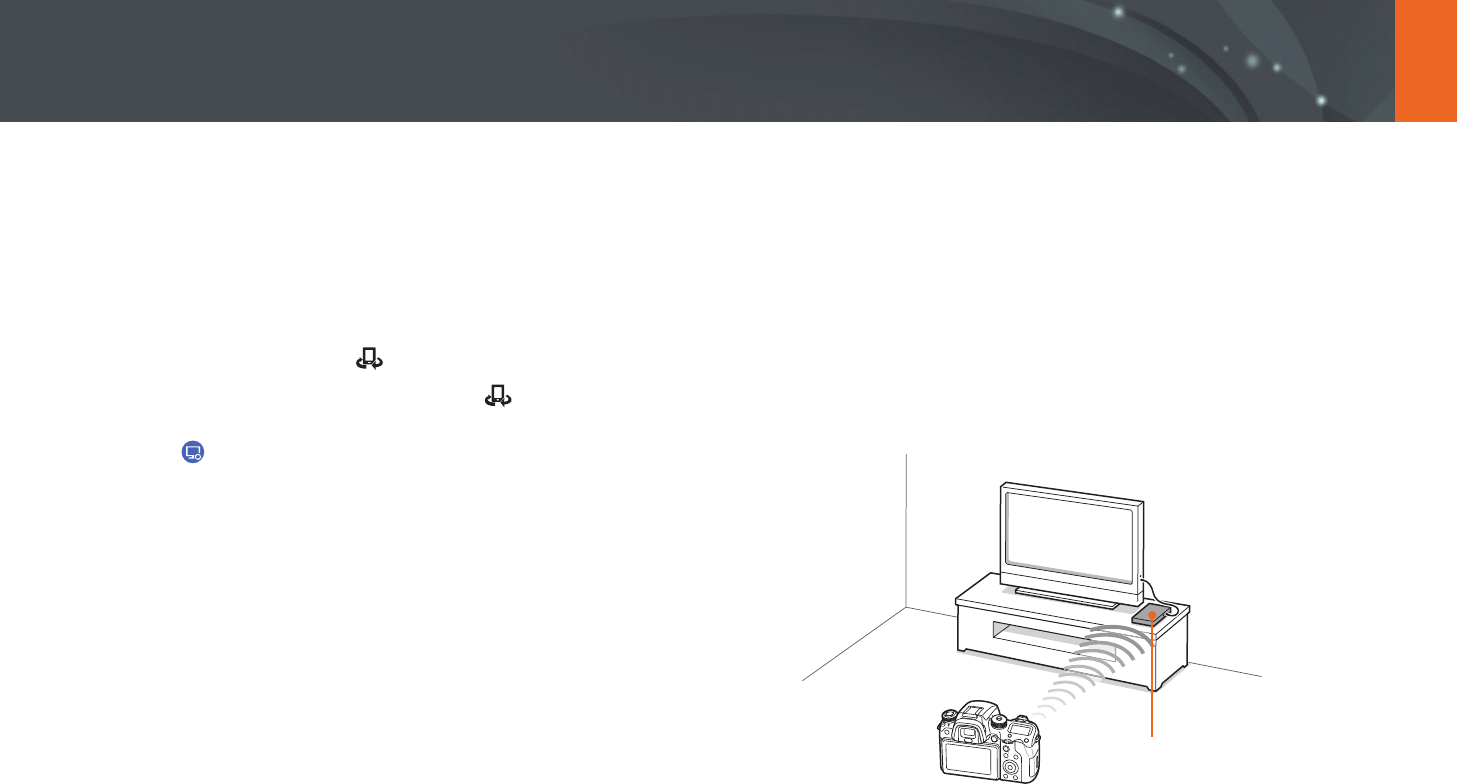
159
Connecting & Transferring
Viewing photos or videos on a TV
Use the TV Link feature or USB cable to play back les from the camera on
a TV.
Connecting wirelessly
1 In Playback mode, touch .
•
You can also select a le, and then select in thumbnails view.
2 Select .
•
If the guide message appears, select OK.
•
The camera will automatically attempt to connect to a WLAN via
the most recently connected AP device.
•
If the camera has not previously been connected to a WLAN, it will
search for available AP devices. (p. 150)
3 Connect the TV Link-enabled TV to a network, and then turn
on the TV Link feature.
•
Refer to the TV’s user manual for more information.
4 Select a TV to connect to from the list.
•
To refresh the list of the TV device, select Refresh.
5 Browse the shared photos or videos.
•
Press [f] to connect to another TV.
•
Press [m] to switch to the thumbnails view.
•
For information about searching for the camera and browsing the
photos or videos on the TV Link-enabled TV, refer to the TV’s user
manual.
•
Videos may not play smoothly depending on the type of TV Link-
enabled TV or the network condition. For smooth playback, use a
5 GHz dual-band AP device.
AP
The camera is connected to a TV that supports TV Link via WLAN.

160
Connecting & Transferring > Viewing photos or videos on a TV
•
You can share up to 1,000 recent les.
•
On a TV Link-enabled TV, you can view only photos or videos captured with
your camera.
•
The range of the wireless connection between your camera and a TV Link-
enabled TV may vary depending on the specications of the AP.
•
If the camera is connected to two TV Link-enabled TVs, playback may be
slower.
•
Photos or videos will be shared in their original sizes.
•
You can use this feature only with TV Link-enabled TVs.
•
Shared photos or videos will not be stored on the TV Link-enabled TV, but
they can be stored in the camera to meet the TV’s specications.
•
Transferring photos or videos to the TV Link-enabled TV may take some time
depending on the network connection, the number of les to be shared, or
the sizes of the les.
•
If you power o the camera abnormally while viewing photos or videos on a
TV Link-enabled TV (for example, by removing the battery), the TV considers
the camera to still be connected.
•
The order of photos or videos on the camera may be dierent than on the TV
Link-enabled TV.
•
Depending on the number of photos or videos you want to share, it may
take some time to load your photos or videos and complete the initial set-up
process.
•
While viewing photos or videos on the TV Link-enabled TV, continuously
using the TV’s remote or performing additional operations on the TV may
prevent this feature from working properly.
•
If you reorder or sort les on the camera while viewing them on a TV Link-
enabled TV, you must repeat the initial set-up process to update the list of
les on the TV.
•
When there are no les in the camera memory, you cannot use this feature.
•
We recommend you use a network cable to connect your TV Link-enabled TV
to your AP. This will minimize any video ’stuttering’ you may experience when
streaming content.
•
To view les on a TV Link-enabled TV, enable multicast mode on your AP.
•
1920X1080 (60 fps) videos can be played only on full HDTVs capable of
playback at 60 fps.
•
You can view 3D les only on 3D-compatible TVs or monitors.

161
Connecting & Transferring > Viewing photos or videos on a TV
Connecting via cable
Play back photos or videos by connecting your camera to an HDTV (3D TV)
using an optional HDMI cable.
Viewing les on an HDTV
1 In Shooting or Playback mode, press [m]
→
q
→
HDMI Output
→
an option. (p. 179)
2 Turn o your camera and HDTV.
3 Connect your camera to your HDTV with the optional HDMI
cable.
4 Turn on your HDTV, and then select the HDMI video source.
5 Turn on the camera.
6 View photos or play videos using the camera buttons.
•
When using the HDMI cable, you can connect the camera to an HDTV using
the Anynet+(CEC) method.
•
The Anynet+(CEC) functions allow you to control connected devices using the
TV remote control.
•
If the HDTV supports Anynet+(CEC), the TV turns on automatically when used
in conjunction with the camera. This feature may not be available on some
HDTVs.
•
You can capture a photo or video when the camera is connected to an HDTV,
but some functions are limited. Shooting functions are supported only when
HDMI Output is set to 1080p or Auto on the camera and the TV’s HDMI
output option is set to 1080p.
•
When connected to an HDTV, some of the camera’s playback functions may
not be available.
•
The length of time after which the camera and an HDTV are connected may
vary depending on the memory card that you are using. As the main feature
of a memory card is to increase the transfer speed, it is not necessarily true
to say that a memory card with a faster transfer speed is also fast in using the
HDMI function.
•
1920X1080 (60 fps) videos can be played only on Full HDTVs capable of
playback at 60 fps.
•
To view 3D photos on a TV that does not support the 3D function, press the
▼
button and switch to Anaglyph mode.
•
You can also play back or capture photos or videos when connected to an
HDMI-enabled monitor. Connections may vary depending on the monitor.
Refer to the monitor’s manual for more details.

162
Connecting & Transferring > Viewing photos or videos on a TV
Viewing les on a 3D TV
You can view photos or videos captured in 3D mode on a 3D TV.
1 In Shooting or Playback mode, press [m]
→
q
→
HDMI Output
→
an option. (p. 179)
2 Turn o your camera and 3D TV.
3 Connect your camera to your 3D TV with the optional HDMI
cable.
4 Turn on your 3D TV, and then select the HDMI video source.
5 Turn on your camera.
6 Move to a 3D le, and then press [h] to switch to 3D mode.
•
Press [h] again to switch to 2D Mode.
7 Turn on your TV’s 3D function.
•
Refer to your TV’s user manual for more details.
8 View 3D photos or play 3D videos using the camera buttons.
•
You cannot view an MPO le in 3D eect on TVs that do not support the le
format.
•
Use proper 3D glasses when you view an MPO le or a 3D video le on a
3D TV.
Do not view the 3D photos or videos captured by your camera on a 3D TV or
3D monitor for an extended period of time. It may cause unpleasant symptoms,
such as eyestrain, fatigue, nausea, and more.

163
Connecting & Transferring
Connecting to a computer
Using Auto Backup for photos or videos
You can send photos or videos that you captured with the camera to a PC
wirelessly.
Installing the program for Auto Backup on your PC
1 Connect the camera to the PC with the USB cable.
2 Turn on the i-Launcher program, and then select PC Auto
Backup.
•
The Auto Backup program is installed on the PC. Follow the on-
screen instructions to complete the installation.
3 Remove the USB cable.
Before installing the program, ensure that the PC is connected to a network.
Using the Auto Backup feature
1 In Playback mode, select a le, and then touch
→
Auto
Backup.
•
In thumbnails view, you cannot use the Auto Backup feature.
•
If the pop-up message that prompts you to download the
application appears, select Next.
•
The camera will automatically attempt to connect to a WLAN via
the most recently connected AP device.
•
If the camera has not previously been connected to a WLAN, it will
search for available AP devices. (p. 150)
2 Select a backup PC.

164
Connecting & Transferring > Connecting to a computer
3 Select OK.
•
To cancel sending, select Cancel.
•
You cannot select individual les to backup. This function backs up
only new les on the camera.
•
The backup’s progress will be shown on the PC monitor.
•
When the transfer is completed, the camera will turn o
automatically in approximately 30 seconds. Select Cancel to return
to the previous screen and prevent the camera from turning o
automatically.
•
To turn o your PC automatically after the transfer is complete,
select Shut down PC after backup.
•
To change the backup PC, select Change PC.
•
When you connect the camera to the WLAN, select the AP that is connected
to the PC.
•
The camera will search for available access points even if you are connecting
to the same access point again.
•
If you turn o the camera or remove the battery while sending les, the le
transfer will be interrupted.
•
While you are using this feature, the shutter control is disabled on your
camera.
•
You can connect only one camera to the PC at a time for sending les.
•
The backup may be canceled due to network conditions.
•
When there are no les in the camera memory, you cannot use this feature.
•
You must turn o Windows Firewall and any other rewalls before using this
feature.
•
You can send up to 1,000 recent les.
•
On the PC software, the server name must be entered in the Latin alphabet
and can contain no more than 48 characters.
•
When multiple le types are created at once, only the image les (JPG) will be
sent to the PC with this feature.
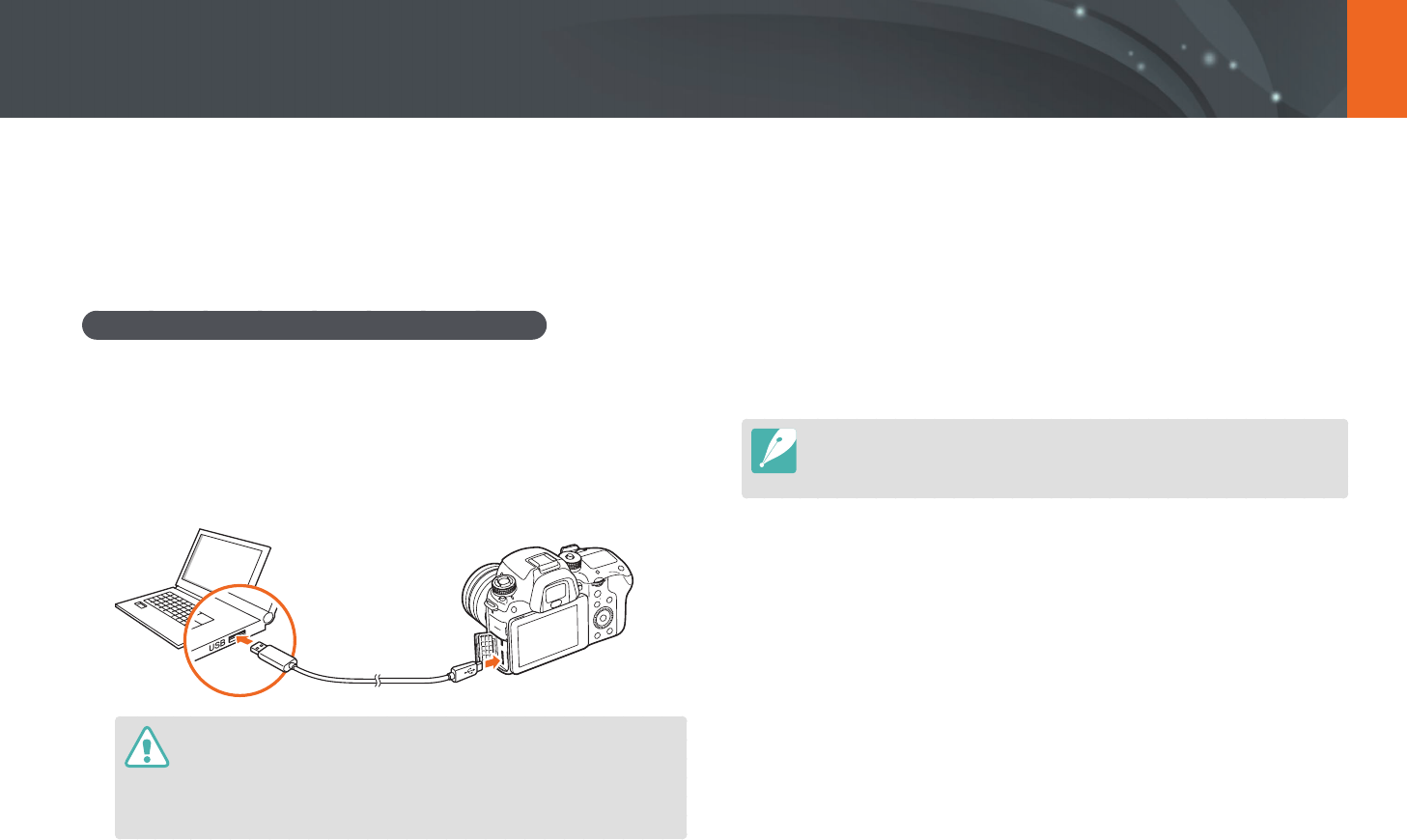
165
Connecting & Transferring > Connecting to a computer
3 Turn on the camera.
•
The computer recognizes the camera automatically.
4 On your computer, select My Computer
→
Removable Disk
→
DCIM
→
100PHOTO or 101_0101.
5 Select the les you want, and then drag or save them to your
computer.
If the Folder Type is set to Date, the folder name appears as “XXX_MMDD“.
For example, if you capture a photo on January 1, the folder name will be
“101_0101“.
Connecting the camera as a removable disk
Transfer les on a memory card to your computer by connecting the
camera to the PC.
Transferring les to your Windows OS computer
You can connect the camera to your computer as a removable disk. Open
the removable disk and transfer les to your computer.
1 Turn o the camera.
2 Connect the camera to your computer with the USB cable.
•
You must plug the small end of the USB cable into your camera. If the
cable is reversed, it may damage your les. The manufacturer is not
responsible for any loss of data.
•
If you try to plug the USB cable into the HDMI port, the camera may not
work properly.
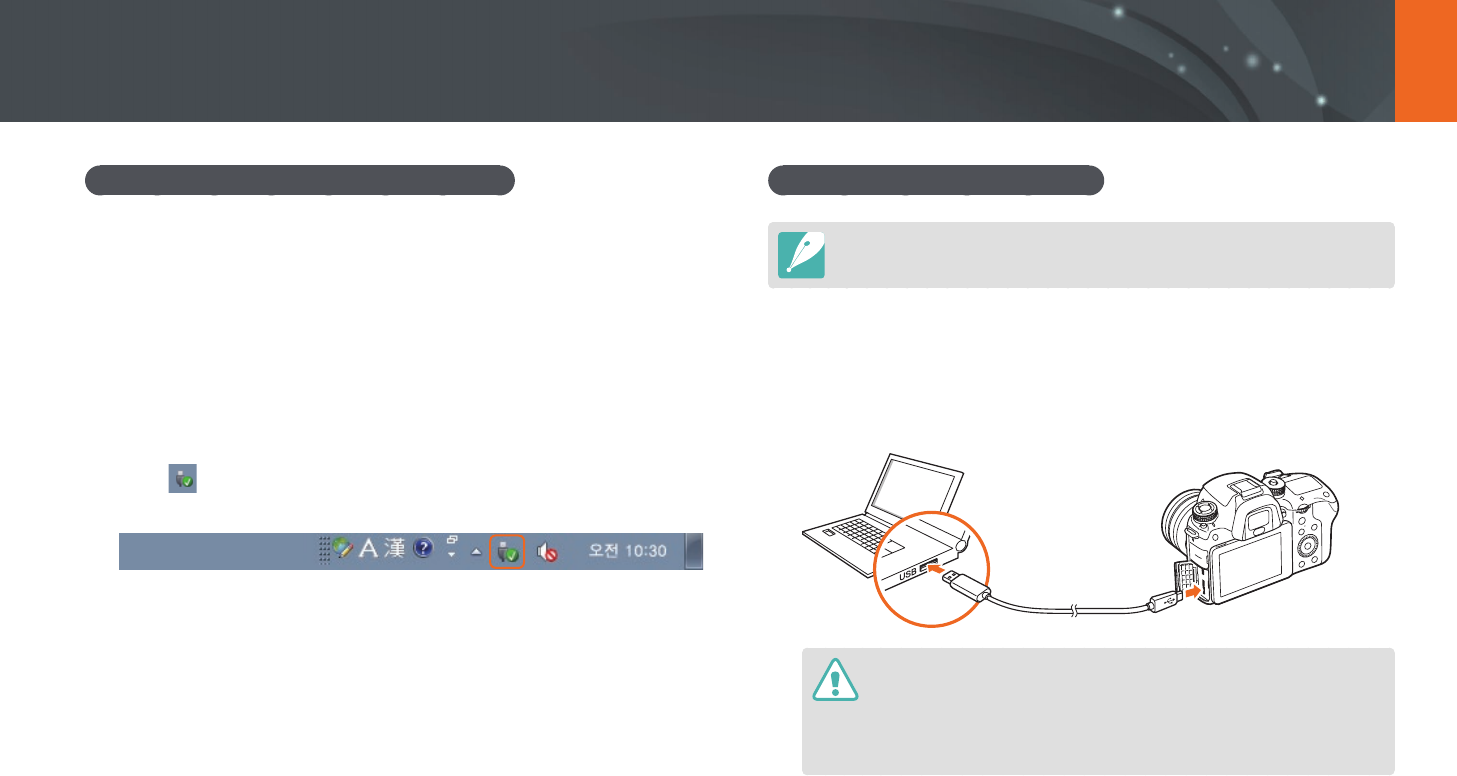
166
Connecting & Transferring > Connecting to a computer
Disconnecting the camera (for Windows 7)
With Windows Vista and Windows 8, the methods for disconnecting the
camera are similar.
1 Ensure that no data is being transferred between the camera
and the computer.
•
If the status lamp on your camera is blinking, it means the data
transfer is in progress. Please wait until the status lamp stops
blinking.
2 Click on the tool bar at the bottom right of your computer
screen.
3 Click the pop-up message.
4 Click the message box indicating safely removed.
5 Remove the USB cable.
Transferring les to your Mac OS
Mac OS 10.5 or later is supported.
1 Turn o the camera.
2 Connect your camera to a Macintosh computer with the USB
cable.
•
You must plug the small end of the USB cable into your camera. If the
cable is reversed, it may damage your les. The manufacturer is not
responsible for any loss of data.
•
If you try to plug the USB cable into the HDMI port, the camera may not
work properly.

167
Connecting & Transferring > Connecting to a computer
3 Turn on the camera.
•
The computer recognizes the camera automatically and displays a
removable disk icon.
4 On your computer, open the removable disk.
5 Transfer photos or videos to the Mac OS computer.

Chapter 5
Camera settings menu
Learn about the user settings and general settings menu.
You can adjust the settings to better suit your needs and preferences.

169
Camera settings menu
You can set the user environment with these settings.
To set user options,
In Shooting mode, press [m]
→
d
→
an option.
Available items and the order of them may dier depending on shooting
conditions.
Manage Custom Mode
Create your own shooting modes by adjusting options and saving them.
Open saved custom modes or delete them.
ISO Customizing
ISO Step
You can set the size for the ISO sensitivity by either 1/3 or 1 step.
Auto ISO Range
You can set the maximum ISO value under which each EV step is chosen
when you set the ISO to Auto.
* Default
Option Value
1/3 Step
ISO 125, ISO 160, ISO 200, ISO 250, ISO 320, ISO 400,
ISO 500, ISO 640, ISO 800, ISO 1000, ISO 1250, ISO 1600,
ISO 2000, ISO 2500, ISO 3200*
1 Step
ISO 200, ISO 400, ISO 800, ISO 1600, ISO 3200*
ISO Expansion
You can select ISO 51200.
User settings

170
Camera settings menu > User settings
Noise Reduction
Use the Noise Reduction to reduce the visual noise in photos.
* Default
Option Description
High ISO NR
This function reduces noise that may occur when you
set a high ISO sensitivity. (O, High, Normal*, Low)
Long Term NR
This function reduces noise when you set the camera
for a long exposure. (O, On*)
DMF (Direct Manual Focus)
You can adjust the focus manually by rotating the focus ring after
achieving the focus by half-pressing [Shutter].
DMF Responsiveness
Set the focus ring response when you use the DMF function. If you select
High, slight rotations of the focus ring are made to adjust the focus. If you
select Low, longer rotations of the focus ring focus are made to adjust the
focus. (High, Medium*, Low)

171
Camera settings menu > User settings
Color Space
The color space option allows you to select methods for representing
colors. Digital imaging devices such as digital cameras, monitors, and
printers have their own methods for representing colors, which are called
color spaces.
* Default
Option Description
sRGB*
sRGB (Standard RGB) is an international specication
to dene the color space created by IEC (International
Electrotechnical Commission). It is widely used for
creating colors on PC monitors and is also the standard
color space for Exif. sRGB is recommended for regular
images and images you intend to publish on the
Internet.
Adobe RGB
Adobe RGB is used for commercial printing and has a
larger color range than sRGB. Its wider range of colors
helps you to easily edit photos on a computer. Note
that individual programs are generally compatible
with a limited number of color spaces.
Adobe RGB
sRGB
When the color space is set to Adobe RGB, photos will be saved as
“_SAMXXXX.JPG“.

172
Camera settings menu > User settings
Distortion Correct
You can correct lens distortion that might occur from lenses.
Touch Operation
Set to enable touch operation in Shooting mode.
* Default
Option Description
O
Do not use touch operations in Shooting mode. (You can use
touch operations in other situations.)
On*
Use touch operations in Shooting mode.
iFn Setting
You can select options that can be adjusted when you press [i-Function]
on an i-Function lens.
Option Description
Aperture
Set to adjust the aperture value.
Shutter speed
Set to adjust the shutter speed.
EV
Set to adjust the exposure value.
ISO
Set to adjust ISO sensitivity.
White Balance
Set to adjust the White Balance.
intelli-Zoom
Set to adjust the zoom scale.
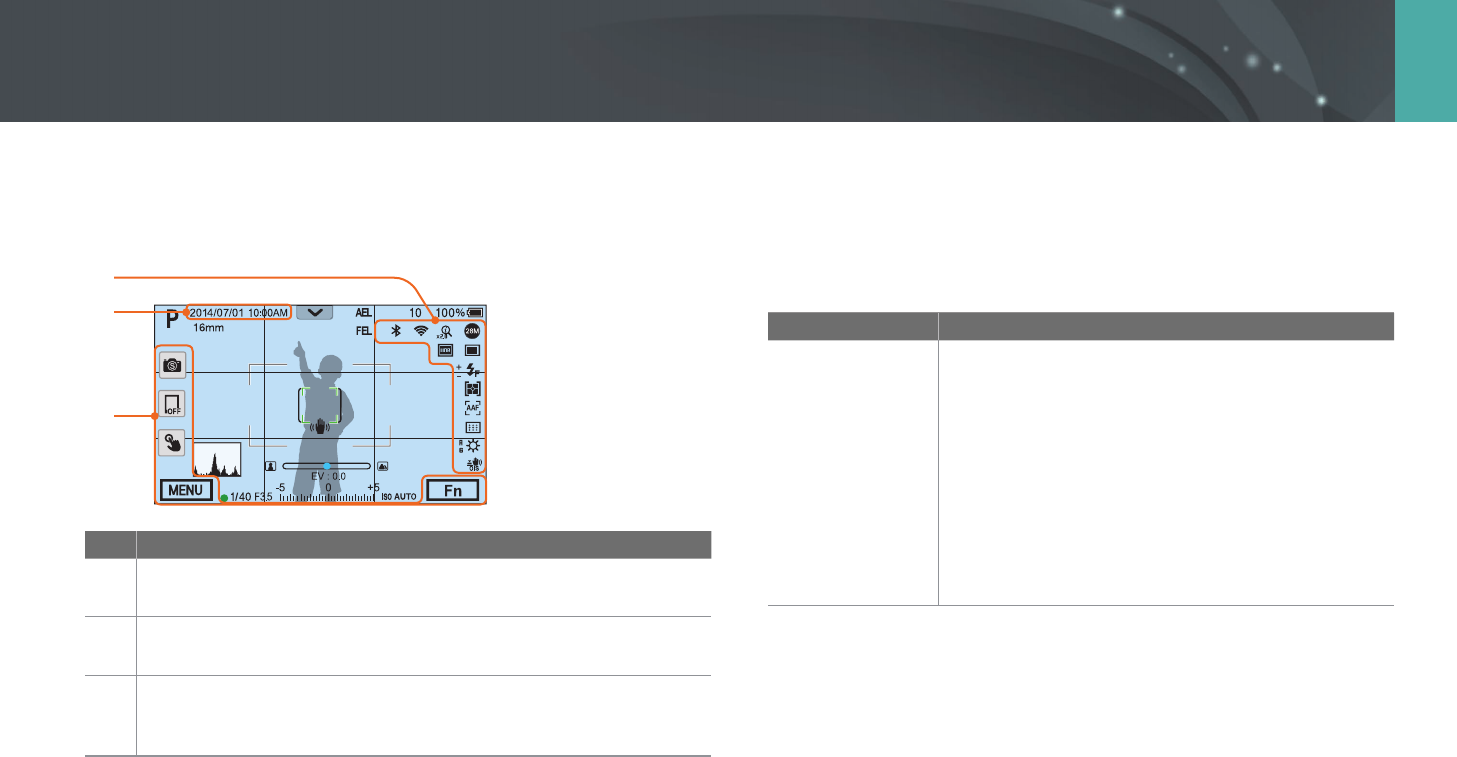
173
Camera settings menu > User settings
User Display
You can add or remove shooting information from the display.
1
2
3
No. Description
1 Icons
Set to display icons on the right in Shooting mode.
2 Date & Time
Set to display the date and time.
3
Button
Set to display touch icons on the left and the bottom in Shooting
mode.
Key Mapping
You can change the function assigned to the Preview button, the AEL
button, the AF start button, the navigation button, or command dial 1/2.
* Default
Button Function
Preview
Set the Preview button’s function.
• Optical Preview*: Execute the Depth of Field
Preview function for the current aperture value.
(p. 25)
• One Touch WB (White Balance): Execute the Custom
White Balance function.
• One Touch RAW +: Save a le in the RAW+JPEG
format. To save a le in JPEG format, press the button
again.
• One Touch HDR: Enable or disable the HDR option
of Dynamic Range.

174
Camera settings menu > User settings
* Default
Button Function
AEL
Set the functions for the AEL button or the AF start
button. You can change the function assigned to each
button to exposure and focus setting, focus lock, or
exposure lock. The AEL and AFL functions save the
exposure value or focus area respectively when you
press [a]. The function executed by half-pressing
[Shutter] varies according to the function assigned to
[a].
• Metering & AF start*: Set an optimum exposure
by calculating the brightness of the focus area and
execute the auto focus function at the same time.
• AEL*: Execute the auto exposure lock function.
(Half-pressing [Shutter] executes the auto focus lock
function.)
• AEL Hold: Keep executing the auto exposure lock
function after shooting. (The exposure remains
locked even after you capture a photo.)
• AFL: Execute the auto focus lock function. (Half-
pressing [Shutter] executes the auto exposure lock
function.)
• AFL Hold: Keep executing the auto focus lock
function after shooting. (The focus remains locked
even after you capture a photo.)
AF-ON
* Default
Button Function
AEL
• AEL + AFL: Execute the auto exposure and focus
lock functions together. (Half-pressing [Shutter]
executes no function.)
• AEL + AFL Hold: Keep executing the auto exposure
and focus lock functions together after shooting.
(The exposure and focus remain locked even after
you capture a photo.)
• FEL: Execute the ash intensity lock function.
(p. 113)
• FEL Hold: Keep executing the ash intensity lock
function after shooting. (The intensity remains
locked even after you capture a photo.) (p. 113)
AF-ON
Custom
◄
Key
Set the function of the left, right, or down navigation
button. (None, AF Mode, AF Area*, White Balance,
ISO, Metering, Touch Operation, Dynamic Range,
Minimum Shutter Speed, Auto ISO Range,
Smart Filter, Picture Wizard*, Continuous Settings,
Timer Settings, Bracket Settings, Flash, i-Zoom,
Focus Peaking, MF Assist, Framing Mode, Grid Line,
Movie STBY*)
Custom
►
Key
Custom
▼
Key
Custom Wheel
Select an item to adjust when rotating the navigation
button. (No, Shutter Speed, Aperture, ISO*, AF Size)
Command Dial
Select an item to adjust when scrolling the command
dial 1 or command dial 2. (Shutter Speed/Aperture*,
Aperture/Shutter Speed)

175
Camera settings menu > User settings
EVF button Interaction
Set to use the viewnder or display when you press [E].
* Default
Option Description
Auto - EVF Only*
Pressing [E] will allow you to view the viewnder or
display in this order:
• Set the proximity sensor to automatically select the
display or viewnder.
• Use the viewnder.
Main Display -
EVF Only
Pressing [E] will allow you to view the viewnder or
display in this order:
• Use the display.
• Use the viewnder.
•
Wi-Fi functions, slideshow functions, interval shots playback, and Manage
Custom Mode, Edit Image functions are not available when you use the
viewnder.
•
The camera does not automatically select the display or viewnder when you
record or play videos. For example, if you start recording or playing a video
while seeing through the viewnder, the main display will not be available
during recording or playing back.
AF Release Priority
Set to capture a photo when the focus is achieved.
* Default
Option Description
Focus*
Capture a photo only when the focus is achieved.
Release
Capture a photo when you press [Shutter] even when
the focus is not achieved.
MobileLink/NFC Image Size
Set the size of photos to transfer to a smart phone using the MobileLink or
NFC functions.
* Default
Option Description
Resize to 2M or
lower
If a photo’s size is larger than 3M, it will be transferred
after resizing it to 2M or lower.
Original*
The photo will be transferred in its original size.

176
Camera settings menu > User settings
Grid Line
Select a guide to help you compose a scene.
(O*, 4 X 4, 3 X 3, Cross, Diagonal)
AF Lamp
When shooting in dark places, turn the AF lamp on in order to have a
better auto focus. The Auto Focus functions more accurately in dark places
when the AF lamp is on. The AF lamp emits the light in irregular vertical
patterns.
E-Shutter
* Default
Option Description
O*
Set to use the mechanical shutter.
On
Set to use the electronic shutter curtain rst and the
mechanical curtain second.
•
This feature is available only when you attach a Samsung lens with Samsung
NX mount.
•
When you use a large diameter lens and a fast shutter speed, a “bokeh“ eect
(an aesthetic blur in out-of-focus areas) may be aected by the subject and
the shooting conditions. To make the bokeh eect appear correctly, set the
E-Shutter to O.
•
When you change the E-Shutter settings, the rst curtain of the shutter is
adjusted and you will hear a noise as the shutter adjusts. This is a normal
situation when preparing the camera to operate the E-Shutter.
•
This feature is not available when you attach the external ash (SEF-580A).
Lens Button Speed Settings
Set the zoom speed for the Power Zoom lens’ buttons at either fast,
medium, or slow speed. At fast speed, zoom noise increases and can be
recorded in videos. This function is available only when you attach the
Power Zoom lens.

177
Camera settings menu
Learn to congure your camera’s settings.
To set Setting
options,
In Shooting or Playback mode, press [m]
→
q
→
an option.
* Default
Item Description
Sound
• System Volume: Set the sound volume or turn all sound
o entirely. (O, Low, Medium*, High)
Even if the system volume is turned o, the camera emits
the sound while playing a video.
• AF Sound: Set the sound the camera emits when you
half-press the shutter button on or o. (O, On*)
• Button Sound: Set the sound the camera emits when
you press the buttons or touch the screen on or o.
(O, On*)
• E-Shutter Sound: Set to emit a sound when you use the
electronic shutter. (O*, On)
•
The camera emits a sound only when the shutter speed
is longer than 0.5 second.
•
This option may not be available in Smart mode.
* Default
Item Description
Quick View
Set the Quick View time length–the amount of time the
camera displays a photo immediately after you capture it.
Select Hold + Focus Zoom to display the image and enlarge
the focus area after shooting.
(O, 1 sec*, 3 sec, 5 sec, Hold, Hold + Focus Zoom)
Display
Adjust
Adjust the display brightness, auto brightness setting,
display color, or level gauge.
• Display Brightness: You can adjust the display
brightness manually.
• Auto Brightness: Turn auto brightness on or o.
(O, On*)
• Display Color: You can adjust the display color manually.
• Horizontal Calibration: Calibrate the level gauge. If the
level gauge is not level, position the camera on the level
surface, and then follow the on-screen instructions.
•
You cannot access the Horizontal Calibration option
in Playback mode.
•
You cannot calibrate the level gauge in portrait
orientation.
Setting

178
Camera settings menu > Setting
* Default
Item Description
Auto Display
O
Set the display o time. The display turns o if you do not
use the camera for the time you set.
(O, 30 sec*, 1 min, 3 min, 5 min, 10 min)
Power Save
Set power shut o time. The camera shuts o if you do not
use it for the time you set. (30 sec, 1 min*, 3 min, 5 min,
10 min, 30 min)
•
The camera retains the power-o time setting even if
you replace the battery.
•
Power Save may not work if the camera is connected to
a computer or a TV or playing a slide show or a movie.
•
Power Save may not work when the camera is
connected to a smart phone and Pro Suggest Market
is in use.
Help Guide
Display
• Mode Help Guide: Set to display help text about the
selected mode when changing shooting modes.
(O*, On)
• Function Help Guide: Set to display help text about
menus and functions. (O, On*)
Press [n] to hide the help text.
* Default
Item Description
Language
Set a language the camera shows on the display.
Date and
Time
Set date, time, date format, and time zone. (Time Zone,
Date Settings, Time Settings, Date Type, Time Type)
Video Out
Set the video signal output appropriate for your country
when connecting the camera to an external video device
such as a monitor or HDTV.
• NTSC: USA, Canada, Japan, Korea, Taiwan, Mexico, etc.
• PAL (Supports only PAL B, D, G, H, or I): Australia, Austria,
Belgium, China, Denmark, Finland, France, Germany,
England, Italy, Kuwait, Malaysia, New Zealand, Singapore,
Spain, Sweden, Switzerland, Thailand, Norway, etc.
Anynet+
(HDMI-CEC)
When you connect the camera to an HDTV that supports
Anynet+ (HDMI-CEC), you can control the play function of
the camera with the TV remote control.
• O: You cannot control the play function of camera with
the TV remote control.
• On*: You can control the play function of camera with the
TV remote control.

179
Camera settings menu > Setting
* Default
Item Description
HDMI Output
When you connect the camera to an HDTV with an HDMI
cable, you can change the resolution of the image.
• NTSC: Auto*, 4096X2160p, 3840X2160p, 1080p, 720p,
480p, 576p (activates only when PAL is selected)
If the connected HDTV does not support the resolution
you select, the camera sets the resolution one level lower.
File Name
Set the method of creating le names.
• Standard*: SAM_XXXX.JPG (sRGB)/
_SAMXXXX.JPG (Adobe RGB)
• Date:
-sRGB les - MMDDXXXX.JPG. For example, for a photo
captured on Jan. 01, the le name would be
0101XXXX.jpg.
-Adobe RGB les - _MDDXXXX.JPG for the months Jan
through Sept. For the months Oct through Dec, the month
number is replaced by the letters A (Oct.), B (Nov.) and
C (Dec.).
For example, for a photo captured on Feb. 03, the le
name would be _203XXXX.jpg. For a photo captured on
Oct. 05, the le name would be _A05XXXX.jpg.
* Default
Item Description
File Number
Set the method of numbering les and folders.
• Reset: After using the reset function, the next le name is
started at 0001.
• Series*: New le numbers continue the existing number
sequence, even if you have installed a new memory card,
formatted the card, or deleted all photos.
•
The rst folder name is 100PHOTO, if you have selected
the sRGB color space and Standard le naming, the rst
le name is SAM_0001.
•
File name numbers are increased by 1 from SAM_0001 to
SAM_9999.
•
Folder numbers are increased by 1 from 100PHOTO to
999PHOTO.
•
The maximum number of les that can be saved in one
folder is 9,999.
•
File numbers are assigned according to DCF (Design rule
for Camera File system) specications.
•
If you change a le name (for example, on a computer),
the camera will not be able to play the le.
Folder Type
Set the type of folder.
• Standard*: XXXPHOTO
• Date: XXX_MMDD
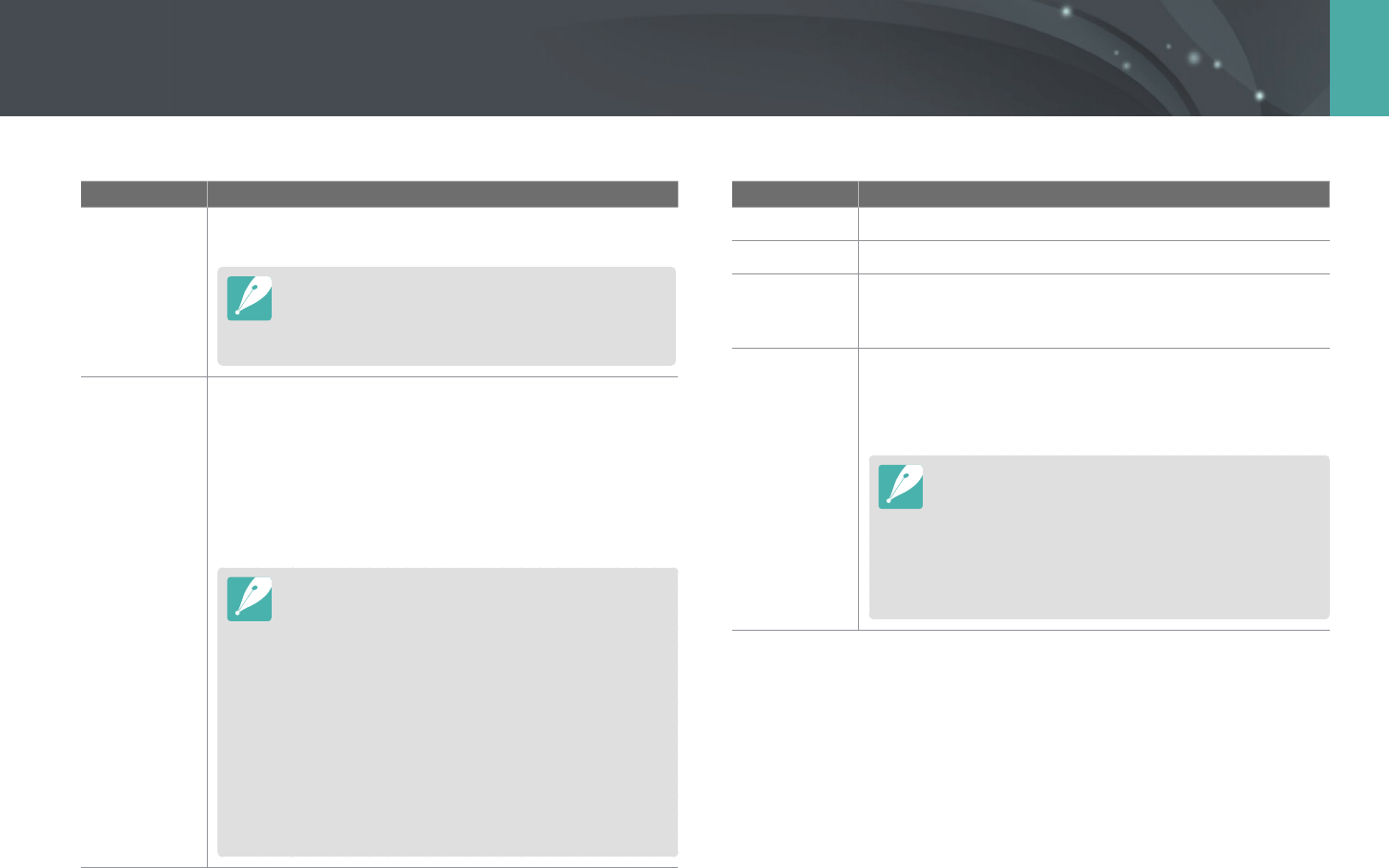
180
Camera settings menu > Setting
* Default
Item Description
Format
Format the memory card. Formatting deletes all existing
les including protected les. (No*, Yes )
Errors can occur if you use a memory card formatted by
another brand of camera, a memory card reader, or a
computer. Please format memory cards in the camera
before using them to capture photos.
Device
Information
View the rmware version of the body and the lens,
Wi-Fi Mac address, Bluetooth Mac address, and network
certication number, or update the rmware.
• Software Update: Update the rmware of the camera
body or lens by connecting the camera to a computer via
USB cable. (Body Firmware, Lens Firmware)
• Wi-Fi Software Update: Update the rmware of the
camera body or lens via Wi-Fi.
•
You can update the rmware by connecting the camera
to the computer and starting i-Launcher. For more
details, refer to page 198.
•
You cannot run a rmware upgrade without a fully
charged battery. Recharge the battery fully before
running a rmware upgrade.
•
If you update the rmware, user settings and values will
be reset. (Date, time, language, and video out will not
change.)
•
Do not turn the camera o while the update is in
progress.
•
Remaining storage on the memory card must be more
than 1 GB to update the rmware via Wi-Fi.
* Default
Item Description
Bluetooth
Set to use the Bluetooth feature. (On*, O)
Wi-Fi Network
Set to connect to a Wi-Fi network. (On, O*)
Bluetooth
Auto Time Set
Set to sync the camera’s date and time with the smart
phone when connecting the camera to a smart phone via
Bluetooth. (O*, On)
Wi-Fi Privacy
lock
Set to require a PIN when connecting the camera and a
smart phone.
• PIN: Enter a PIN before connecting.
• None*: Allow a connection without requiring a PIN.
•
Connections will automatically be made without
requiring a PIN when using the NFC function.
•
PINs are automatically generated and renewed only
when you reset the camera settings or update the
rmware.
•
If you have previously connected your camera to a
smart phone via a PIN, they will connect automatically.

181
Camera settings menu > Setting
* Default
Item Description
Dual-band
Mobile AP
Set a frequency for using the camera as an AP for the Quick
Transfer, MobileLink, or Remote Viewnder features.
(2.4 GHz*, 5 GHz)
If you use the camera in a country other than the one
where it was purchased, the 5 GHz Wi-Fi feature may not
function properly, due to dierences in radio frequencies.
In this case, use the 2.4 GHz Wi-Fi feature instead.
Sensor
Cleaning
• Sensor Cleaning: Remove dust from the sensor.
• Start-Up Action: When on, the camera performs sensor
cleaning each time you turn it on. (O*, On)
• Shut down Action: When on, the camera performs
sensor cleaning each time you turn it o. (O*, On)
As this product uses interchangeable lenses, the sensor
can get dust on it when you change lenses. This can lead
to dust particles appearing in the photos you capture. It
is recommended not to change lenses when you are in a
particularly dusty area. Also, make sure to attach the lens
cap to the lens when not using it.
* Default
Item Description
Battery
Selection
Set the priority of using and charging the internal battery
(the camera) and external battery (a vertical grip) when
using a vertical grip. This function is supported only when
the vertical grip is attached.
• Auto*: Use the external battery (a vertical grip) rst and
charge the internal battery (the camera) rst.
• Internal: Use and charge the internal battery (the
camera) rst. Use the external battery (a vertical grip)
after the internal battery (the camera) depletes.
• External: Use and charge the external battery (a vertical
grip) rst. Use the internal battery (the camera) after the
external battery (a vertical grip) depletes.
Reset
• Camera Menu*: Return the setup menu and shooting
options to the factory defaults.
• Key Mapping: Return the custom button functions to the
factory defaults.
• C1/C2 Mode: Return the Custom 1 and Custom 2 mode
settings to the factory defaults.
• Bluetooth/Wi-Fi: Return the connection history, ID, and
password of the Bluetooth and Wi-Fi functions to the
factory defaults.
• All: Return all settings to the factory defaults. (Date, time,
language, and video output settings will not change.)
Open Source
License
View open source licenses.

Chapter 6
Appendix
Get information about error messages, camera maintenance, using programs on a computer,
rmware updates, troubleshooting tips, specications, and glossary terms.

183
Appendix
When the following error messages appear, try these remedies.
Error messages Suggested remedies
Lens is locked
The lens is locked. Rotate the lens counter-
clockwise until you hear a click. (p. 59)
Card Error
• Turn o the camera, and then turn it on again.
• Remove the memory card and insert it again.
• Format the memory card.
Low Battery
Insert a charged battery or recharge the battery.
No Image File
Capture photos or insert a memory card that
contains photos.
File Error
Delete the damaged le or contact a service
center.
Memory Full
Delete unnecessary les or insert a new memory
card.
Card Locked
You can lock SD, SDHC, or SDXC card to prevent
les from being deleted. Unlock the card when
shooting. (p. 187)
Error messages Suggested remedies
Unable to capture a
photo because folder
and le number on
the memory card
reached the maximum
values. Reset the
folder number?
File names do not match the DCF standard. Follow
the on-screen instructions to reset the folder
number.
Error 00
Turn o your camera and remount the lens. If the
message still appears, contact a service center.
Error 01/02
Turn o your camera, remove the battery, and
insert again. If the message still appears, contact a
service center.
Error messages

184
Appendix
Cleaning the camera
Camera lens and display
Use a brush to remove dust and wipe the lens gently with a soft cloth.
If any dust remains, apply lens cleaning liquid to a piece of cleaning paper
and wipe gently.
Image sensor
Depending on dierent shooting conditions, dust may appear in photos
because the image sensor is exposed to the external environment. This
problem is normal, and the exposure to dust occurs in everyday use
of the camera. You can remove dust from the sensor by operating the
sensor cleaning function. (p. 181) If dust remains after cleaning the sensor,
contact a service center. Do not insert the blower into the mounting
opening of the lens.
Camera body
Wipe gently with a soft, dry cloth.
Never use benzene, thinners, or alcohol to clean the device. These solutions can
damage the camera or cause it to malfunction.
Maintaining the camera

185
Appendix > Maintaining the camera
Using on beaches or shores
•
Protect your camera from sand and dirt when you use it on beaches or in
other similar areas.
•
Your camera is not waterproof. Do not handle the battery, adapter, or
memory card with wet hands. Operating the camera with wet hands
may cause damage to your camera.
Storing for extended period of time
•
When you store the camera for an extended period, place it in a sealed
container with an absorbent material, such as silica gel.
•
Over time, unused batteries will discharge and must be recharged before
use.
•
The present date and time can be initialized when the camera is turned
on after the camera and battery have been separated for a prolonged
period.
Using or storing the camera
Inappropriate places to use or store the camera
•
Avoid exposing the camera to very cold or very hot temperatures.
•
Avoid using your camera in areas with extremely high humidity, or
where the humidity changes drastically.
•
Avoid exposing the camera to direct sunlight and storing it in hot, poorly
ventilated areas, such as in a car during summer time.
•
Protect your camera and the display from impact, rough handling, and
excessive vibration to avoid serious damage.
•
Avoid using or storing your camera in dusty, dirty, humid, or poorly
ventilated areas to prevent damage to moving parts and internal
components.
•
Do not use your camera near fuels, combustibles, or ammable
chemicals. Do not store or carry ammable liquids, gases, or explosive
materials in the same compartment as the camera or its accessories.
•
Do not store the camera where there are mothballs.

186
Appendix > Maintaining the camera
Using the camera with caution in humid environments
When you transfer the camera from a cold environment to a warm one,
condensation can form on the lens or internal components of the camera.
In this situation, turn o the camera and wait for at least 1 hour.
If condensation forms on the memory card, remove the memory card from
the camera and wait until all moisture has evaporated before reinserting it.
Other cautions
•
Do not swing your camera by the strap. This may cause injury to yourself
or others or damage to your camera.
•
Do not paint your camera, as paint can clog moving parts and prevent
proper operation.
•
Turn o the camera when not using it.
•
Your camera consists of delicate parts. Avoid impacts to the camera.
•
Protect the display from external force by keeping it in the case when
not in use. Protect the camera from scratches by keeping it away from
sand, sharp implements, or loose change.
•
Do not use the camera if the screen is cracked or broken. Broken glass or
acrylic could cause injury to your hands and face. Take the camera to a
Samsung service center to have it repaired.
•
Never place cameras, batteries, chargers, or accessories near, on, or in
heating devices, such as microwave ovens, stoves, or radiators. Heat can
deform or overheat these devices, which can cause a re or explosion.
•
Do not expose the lens to direct sunlight, as this may discolor the image
sensor or cause it to malfunction.
•
Protect your lens from ngerprints and scratches. Clean your lens with a
soft, clean, debris-free lens cloth.
•
The camera may turn o if impacted from the outside. This is to protect
the memory card. Turn on the camera to use it again.
•
While you use the camera, it may heat up. This is normal and should not
aect your camera’s lifespan or performance.
•
When you use the camera in low temperatures, it may take some time to
turn on, the color of the display may be changed temporarily, or after-
images may appear. These conditions are not malfunctions and they will
correct themselves when the camera is returned to milder temperatures.
•
Paint or metal on the outside of the camera may cause allergies,
itchy skin, eczema, or swelling for people with sensitive skin.
If you experience any of these symptoms, stop using the camera
immediately and consult a doctor.
•
Do not insert foreign objects into any of your camera’s compartments,
slots, or access points. Damage due to improper use may not be covered
by your warranty.
•
Do not allow unqualied personnel to service the camera or attempt to
service the camera yourself. Any damage that results from unqualied
service is not covered by your warranty.
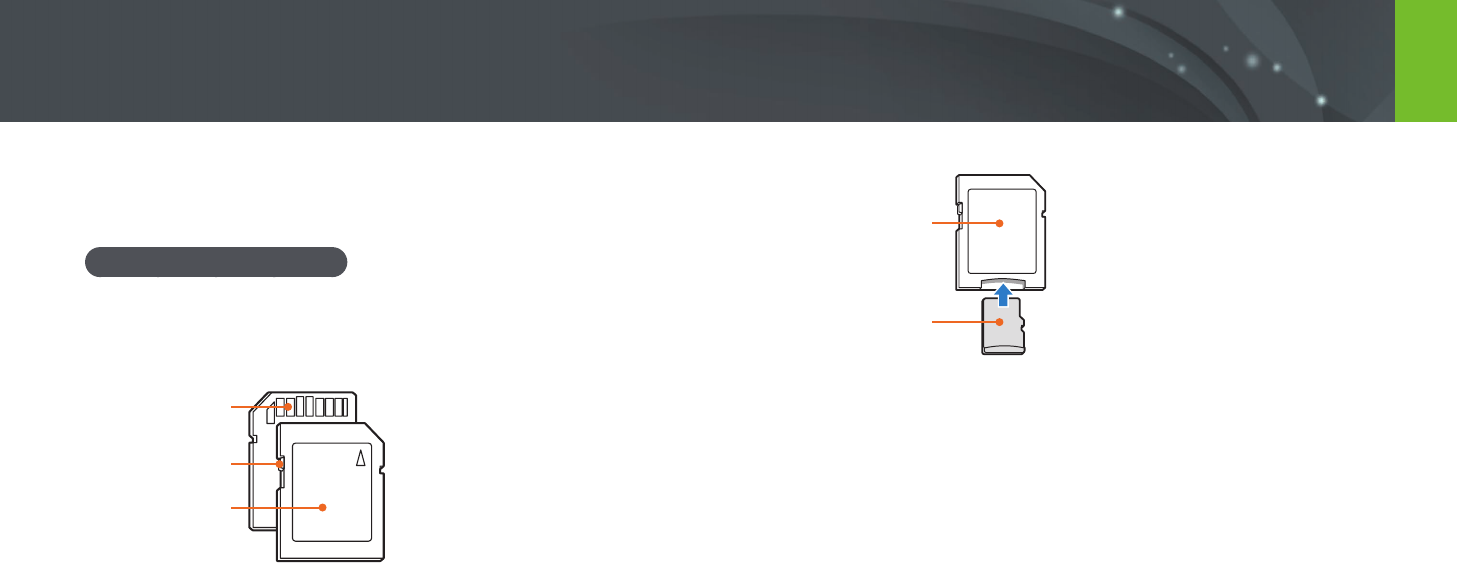
187
Appendix > Maintaining the camera
About memory card
Supported memory card
This product supports SD (Secure Digital), SDHC (Secure Digital High
Capacity), SDXC (Secure Digital eXtended Capacity), microSD, microSDHC,
or microSDXC memory cards.
Terminal
Write-protect switch
Label (front)
You can prevent les from being deleted by using the write-protect switch
on an SD, SDHC, or SDXC card. Slide the switch down to lock or slide it up
to unlock. Unlock the card when capturing photos and videos.
Memory card adapter
Memory card
To use micro memory cards with this product, a PC, or a memory card
reader, insert the card into an adapter.

188
Appendix > Maintaining the camera
Memory card capacity
The memory capacity may dier depending on shooting scenes or shooting conditions. These capacities are based on a 2 GB SD card.
Size Quality
Super Fine Fine Normal RAW RAW + S.Fine RAW + Fine RAW + Normal
Photo
28.0M (6480X4320) XXX XXX XXX XXX XXX XXX XXX
13.9M (4560X3040) XXX XXX XXX -XXX XXX XXX
7.1M (3264X2176) XXX XXX XXX -XXX XXX XXX
3.0M (2112X1408) XXX XXX XXX -XXX XXX XXX
23.0M (6480X3648) XXX XXX XXX ----
11.9M (4608X2592) XXX XXX XXX -XXX XXX XXX
6.2M (3328X1872) XXX XXX XXX -XXX XXX XXX
2.4M (2048X1152) XXX XXX XXX -XXX XXX XXX
18.7M (4320X4320) XXX XXX XXX -XXX XXX XXX
9.5M (3088X3088) XXX XXX XXX -XXX XXX XXX
4.7M (2160X2160) XXX XXX XXX -XXX XXX XXX
2.0M (1408X1408) XXX XXX XXX -XXX XXX XXX

189
Appendix > Maintaining the camera
Size Quality
HQ Normal
Video
4096X2160 (24 fps) Approx. XX' XX" Approx. XX' XX"
3840X2160 (30 fps Approx. XX' XX" Approx. XX' XX"
1920X1080 (60 fps) Approx. XX' XX" Approx. XX' XX"
1920X1080 (30 fps) Approx. XX' XX" Approx. XX' XX"
1920X1080 (24 fps) Approx. XX' XX" Approx. XX' XX"
* 1920X1080 (15 fps) Approx. XX' XX" Approx. XX' XX"
1280X720 (60 fps) Approx. XX' XX" Approx. XX' XX"
1280X720 (30 fps) Approx. XX' XX" Approx. XX' XX"
640X480 (60 fps) Approx. XX' XX" Approx. XX' XX"
640X480 (30 fps) Approx. XX' XX" Approx. XX' XX"
* is available only with some Smart Filter options.
•
The gures above are measured without using the zoom function.
•
Available recording time may vary if you use the zoom.
•
Several videos were recorded in succession to determine the total recording time.
•
The maximum recording time is 29 minutes and 59 seconds per le.

190
Appendix > Maintaining the camera
•
Prevent memory cards from making contact with liquids, dirt, or foreign
substances. If dirty, wipe the memory card clean with a soft cloth before
you insert the memory card in your camera.
•
Do not allow liquids, dirt, or foreign substances to come in contact with
memory cards or the memory card slot. Doing so may cause memory
cards or the camera to malfunction.
•
When you carry a memory card, use a case to protect the card from
electrostatic discharges.
•
Transfer important data to other media, such as a hard disk, CD, or DVD.
•
When you use the camera for an extended period, the memory card may
become warm. This is normal and does not indicate a malfunction.
•
Use a memory card that meets the standard requirements.
The manufacturer is not responsible for any loss of data.
Cautions when using memory cards
•
Avoid memory cards to very cold or very hot temperatures (below
0 °C/32 °F or above 40 °C/104 °F). Extreme temperatures can cause
memory cards to malfunction.
•
Insert a memory card in the correct direction. Inserting a memory card in
the wrong direction may damage your camera and memory card.
•
Do not use memory cards that have been formatted by other cameras or
by a computer. Reformat the memory card with your camera.
•
Turn o the camera when you insert or remove the memory card.
•
Do not remove the memory card or turn o your camera while the lamp
is blinking, as this may damage your data.
•
When the lifespan of a memory card has expired, you cannot store any
more photos on the card. Use a new memory card.
•
Do not bend, drop, or subject memory cards to heavy impact or
pressure.
•
Avoid using or storing memory cards near strong magnetic elds.
•
Avoid using or keeping memory cards in areas with high temperature,
high humidity, or corrosive substances.

191
Appendix > Maintaining the camera
•
Do not rest the device on ammable surfaces, such as bedding, carpets, or
electric blankets for a prolonged period.
•
When the device is switched on, do not leave it in any conned space for a
prolonged period.
•
Do not allow battery terminals to come in contact with metallic objects, such
as necklaces, coins, keys, or watches.
•
Use only authentic, manufacturer-recommended, Lithium-ion replacement
batteries.
•
Do not disassemble the battery or puncture it with any sharp object.
•
Avoid exposing the battery to high pressure or crushing forces.
•
Avoid exposing the battery to major impacts, such as dropping it from high
places.
•
Do not expose the battery to temperatures of 60 °C (140 °F) or above.
•
Do not allow the battery to come in contact with moisture or liquids.
•
Battery shall not be exposed to excessive heat such as sunshine, re, or the
like.
Disposal guidelines
•
Dispose of the battery with care.
•
Do not dispose of the battery in a re.
•
Disposal regulations may dier by country or region. Dispose of the battery in
accordance with all local and federal regulations.
Guidelines for charging the battery
Charge the battery only by the method described in this user manual.
The battery can ignite or explode if not charged properly.
About the battery
Use only Samsung-approved batteries.
Battery specications
Item Description
Model
BP1900
Type
Lithium-ion battery
Cell capacity
1,900 mAh
Voltage
7.2 V
Charging time* (When the battery
is completely discharged.)
Approx. XXX min.
* The gures above are based on when you use the provided USB cable and AC adaptor.
Charging the battery by connecting it to a computer may take longer.
Personal injury or death can occur if the battery is handled carelessly or
improperly. For your safety, follow these instructions for proper battery
handling:
•
The battery can ignite or explode if not handled properly. If you notice
any deformities, cracks, or other abnormalities in the battery, immediately
discontinue use of the battery and contact your manufacturer.
•
Use only authentic, manufacturer-recommend battery chargers and charge
the battery only by the method described in this user manual.
•
Do not place the battery near heating devices or expose to excessively warm
environments, such as the inside of an enclosed car in the summertime.
•
Do not place the battery in a microwave oven.
•
Avoid storing or using the battery in hot, humid places, such as spas or
shower enclosures.

192
Appendix > Maintaining the camera
Battery life
Shooting mode Average time / Number of photos
Photos
Approx. XXX min./Approx. XXX photos
Videos
Approx. XXX min. (Record videos at 1920X1080
resolution and 30 fps.)
•
The gures above are based on the CIPA test standards.
Your results may dier depending on your actual usage.
•
Available shooting time diers depending on background, shooting
interval, and use conditions.
•
Several videos were recorded in succession to determine the total
recording time.
Low battery message
When the battery has fully discharged, the battery icon will turn red and
the “Low Battery“ message will appear.
Notes about using the battery
•
Avoid exposing batteries to very cold or very hot temperatures (below
0 °C/32 °F or above 40 °C/104 °F). Extreme temperatures can reduce the
charging capacity of your batteries.
•
When you use the camera for an extended period, the area around the
battery chamber may become warm. This does not aect the normal use
of the camera.
•
Do not pull the power supply cord to disconnect the plug from the
power outlet, as this may cause a re or electric shock.
•
In temperatures below 0 °C/32 °F, battery capacity and battery life may
decrease.
•
Battery capacity may decrease in low temperatures, but will return to
normal in milder temperatures.
•
Remove the batteries from your camera when storing it for an extended
period. Installed batteries may leak or corrode over time and cause
serious damage to your camera. Storing the camera for extended
periods with the battery installed causes the battery to discharge. You
may not be able to recharge a fully discharged battery.
•
When you do not use the camera for an extended period (3 months or
more), check the battery and recharge it regularly. If you let the battery
discharge continually, its capacity and life may decrease, which can lead
to a malfunction, re, or explosion.

193
Appendix > Maintaining the camera
Cautions about using the battery
Protect batteries, chargers, and memory cards from damage.
Prevent batteries from making contact with metal objects, as this can
create a connection between the + and – terminals of your battery and
lead to temporary or permanent battery damage and may cause a re or
electric shock.
Notes about charging the battery
•
If the status lamp is o, ensure that the battery is inserted correctly.
•
If the camera is on while charging, the battery may not fully charge. Turn
o the camera before charging the battery.
•
Do not use your camera when you are charging the battery. This may
cause a re or electric shock.
•
Do not pull the power supply cord to disconnect the plug from the
power outlet, as this may cause a re or electric shock.
•
Let the battery charge for at least 10 minutes before turning on the
camera.
•
If you connect the camera to an external power source when the battery
is depleted, using high energy-consuming functions will cause the
camera to turn o. To use the camera normally, recharge the battery.
•
If you reconnect the power cable when the battery is fully charged, the
status lamp turns on for approximately 30 minutes.
•
Using the ash or recording videos depletes the battery quickly. Charge
the battery fully before using the camera.
•
If the status lamp blinks in red, reconnect the cable, or remove the
battery and insert it again.
•
If you charge the battery when the cable is overheated or the
temperature is too high, the status lamp may blink in red. Charging will
start when the battery cools down.
•
Overcharging batteries may shorten battery life. After charging is
nished, disconnect the cable from your camera.
•
Do not bend or place heavy objects on the AC cable. Doing so may
damage the cable.

194
Appendix > Maintaining the camera
Notes about charging with a computer connected
•
Use only the provided USB cable.
•
The battery may not charge when:
-you use a USB hub
-other USB devices are connected to your computer
-you connect the cable to the port on the front side of your computer
-the USB port of your computer does not support the power output standard
(5 V, 500 mA)
Handle and dispose of batteries and chargers with care
•
Never dispose of batteries in a re. Follow all local regulations when you
dispose of used batteries.
•
Never place batteries or cameras on or in heating devices, such as
microwave ovens, stoves, or radiators. Batteries may explode when they
are overheated.

195
Appendix
Using programs on a PC
You can view and edit les using the provided programs. You can also send
the les to a PC wirelessly.
Using i-Launcher
i-Launcher allows you to update the rmware of the camera or the lens, or
download the User Manual. It also allows you to download and install the
Movie Converter, DNG Converter, and PC Auto Backup program.
Opening i-Launcher
On your computer, select Start
→
All Programs
→
Samsung
→
i-Launcher
→
Samsung i-Launcher. Or, click Applications
→
Samsung
→
i-Launcher on your Mac OS computer.
Available programs
Icon Description
Software Update
Download the rmware of the camera body or lens.
For information about updating the rmware, refer to
page 198.
Manual
Download
Download the User Manual.
Movie Converter
Download this program to convert HEVC les to
another format. To edit video les using some editing
programs, convert HEVC les to another format
(ProRes 422 or H.264).
DNG Converter
Download this program to convert Samsung RAW les
(SRW) to DNG les.
PC Auto Backup
i-Launcher provides a link for downloading the PC
Auto Backup program when you connect the camera
to a computer. You can send photos or videos that
you captured with the camera to a PC wirelessly. For
information about installing PC Auto Backup, refer to
page 163.
Samsung RAW
Converter
Download this program to convert RAW les into the
desired le format.

196
Appendix > Using programs on a PC
Installing i-Launcher on a PC
If your web browser or operating system does not support the web version
of i-Launcher, you can install the PC version. Connect your camera to the
computer and follow the on-screen instructions to install i-Launcher.
Requirements for Windows OS
Item Requirements
CPU
Intel® i5 3.3 GHz or higher/
AMD Phenom™ IIx4 3.2 GHz or higher
RAM
Minimum 512 MB RAM (1 GB or more recommended)
OS*
Windows 7, Windows 8
Hard disk
capacity
250 MB or more (1 GB and above recommended)
Others
• CD-ROM drive
• 1024X768 pixels, 16-bit color display compatible
monitor or higher (1280X1024 pixels, 32-bit color
display recommended)
• USB 2.0 or 3.0 port
• nVIDIA Geforce 7600GT or higher/
ATI X1600 series or higher
* A 32-bit version of i-Launcher will be installed—even on 64-bit editions of Windows 7 and
Windows 8.
•
The requirements on the following page are recommendations only.
i-Launcher may not work properly even when the computer meets the
requirements, depending on the condition of your computer.
•
If your computer does not meet the requirements, videos may not play
correctly.
The manufacturer is not responsible for any damage that results from using
unqualied computers such as a computer you assembled yourself.
Requirements for Mac OS
Item Requirements
OS
Mac OS 10.5 or higher (except PowerPC)
RAM
Minimum 256 MB RAM (512 MB or more
recommended)
Hard disk capacity
Minimum 110 MB
Others
USB 2.0 or 3.0 port, CD-ROM drive

197
Appendix > Using programs on a PC
Installing Samsung RAW Converter
Launch i-Launcher, and then follow the on-screen instructions to install the
program.
Using Samsung RAW Converter
Photos captured by a camera are often transformed to JPEG formats and
stored in the memory according to the settings of the camera at the time
of shooting. RAW les are not transformed to JPEG formats and are stored
in the memory without any changes. With Samsung RAW Converter, you
can calibrate exposures, White Balances, tones, contrasts, and colors of
photos. You can also edit JPEG or TIFF les as well as RAW les. For more
information, refer to the program guide.
•
Depending on your version of Samsung RAW Converter, you may not be able
to open RAW les. In this case, update the program.
•
In Samsung RAW Converter, an image’s brightness, color and other eects
may be displayed dierently. This occurs because the original camera settings
and options applied during image capture are removed, ready for it to be
processed in Samsung RAW Converter.
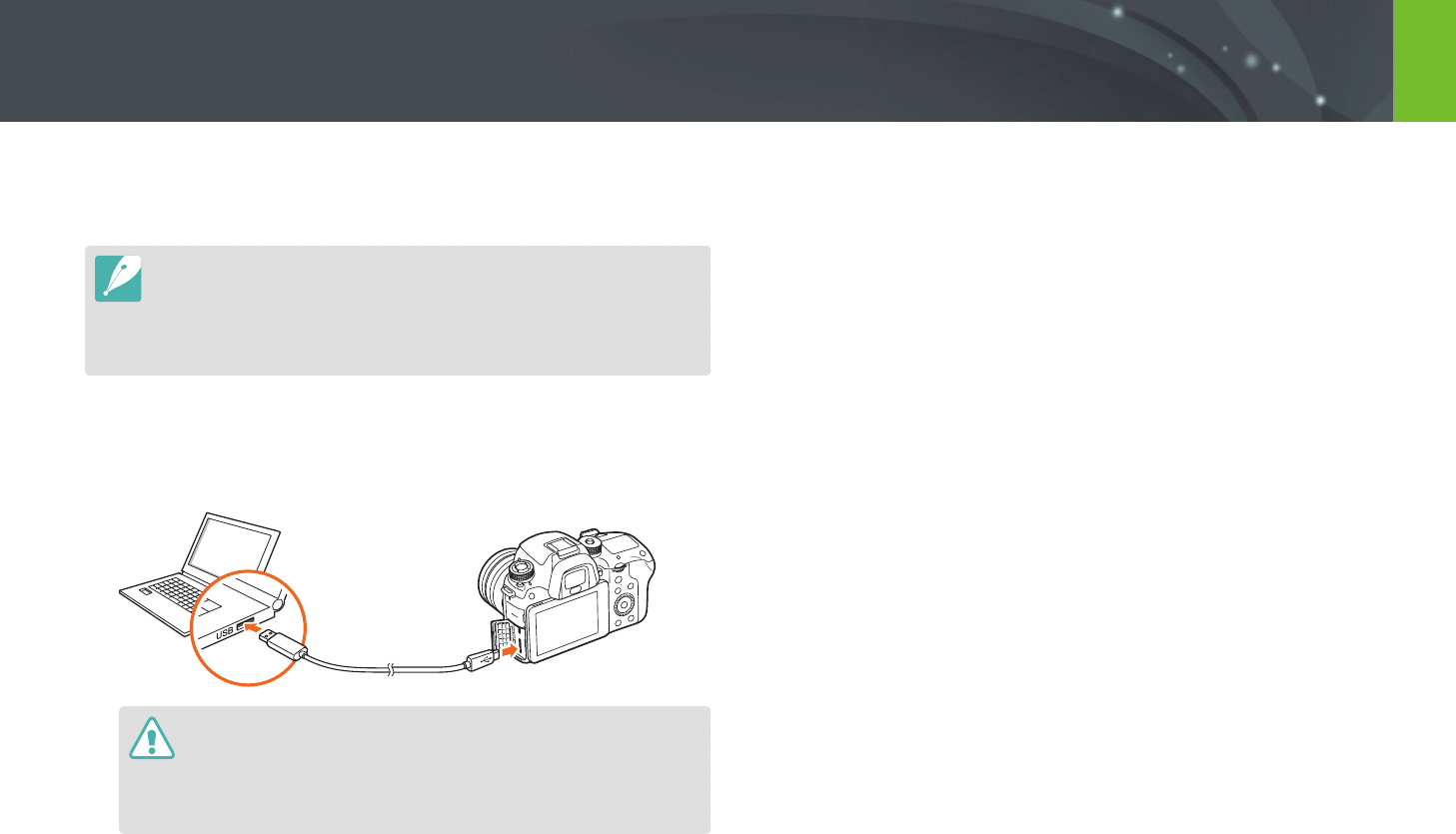
198
Appendix
Updating the firmware
Connect the camera to the computer and update the rmware of the
camera of the lens.
•
You cannot run a rmware upgrade without a fully charged battery. Recharge
the battery fully before running a rmware upgrade.
•
If you update the rmware, user settings and values will be reset. (Date, time,
language, and video out will not change.)
•
Do not turn the camera o while the update is in progress.
1 Turn o the camera.
2 Connect your camera to the computer with the USB cable.
•
You must plug the small end of the USB cable into your camera. If the
cable is reversed, it may damage your les. The manufacturer is not
responsible for any loss of data.
•
If you try to plug the USB cable into the HDMI port, the camera may not
work properly.
3 Turn on the camera.
4 On the computer, select i-Launcher
→
Software Update.
5 Follow the on-screen instructions to download the rmware to
the camera.
•
You can download the rmware of the camera or the lens.
6 Turn o the camera when the download completes.
7 Remove the USB cable.
8 Turn on the camera.
9 Press [m]
→
q
→
Device Information
→
Software
Update
→
Body Firmware
or
Lens Firmware
.
10
Select Ye s from a pop-up window on the camera to update
the rmware.

199
Appendix
Before contacting a service center
If you are having trouble with your device, try these troubleshooting
solutions before contacting a service professional.
When you leave your camera at a service center, be sure to also leave the other
components that may have contributed to the malfunction, such as the memory
card and battery.
Situation Suggested remedies
Cannot turn on the
camera
• Ensure that the battery is inserted.
• Ensure that the battery is inserted correctly.
• Charge the battery.
The power turns o
suddenly
• Charge the battery.
• Your camera may be in Power save mode or the
display turns o automatically. (p. 178)
• The camera may be turned o automatically to
prevent the memory card from being damaged
due to excessive heat. Turn on your camera
again.
The camera is losing
battery power quickly
• The battery may lose power more quickly in
low temperatures (below 0 °C/32 °F). Keep the
battery warm by putting it into your pocket.
• Using the ash or recording videos depletes the
battery quickly. Recharge if needed.
• Batteries are consumable parts that must be
replaced over time. Get a new battery if the
battery life is diminishing quickly.
Situation Suggested remedies
Cannot capture
photos
• There is no space on the memory card. Delete
unnecessary les or insert a new card.
• Format the memory card.
• The memory card is defective. Get a new
memory card.
• The memory card is locked. Unlock the card.
(p. 187)
• Ensure that the camera is switched on.
• Charge the battery.
• Ensure that the battery is inserted correctly.
The camera freezes
Remove the battery and insert it again.
The camera heats up
While using the camera, it may heat up.
This is normal and should not aect your camera’s
lifespan or performance.
The ash res
unexpectedly
The ash may re due to static electricity.
The camera is not malfunctioning.
The ash does not
work
• The ash option may be set to O. (p. 108)
• You cannot use the ash in some modes.
The date and time are
incorrect
Set the date and time under the q menu.
(p. 178)
The display or buttons
do not work
Remove the battery and insert it again.

200
Appendix > Before contacting a service center
Situation Suggested remedies
The memory card has
an error
• Turn o the camera, and then turn it on again.
• Remove the memory card, and then insert it
again.
• Format the memory card.
See “Cautions when using memory cards“ for
more details. (p. 190)
Your computer does
not recognize an
SDXC or UHS-1/UHS-2
memory card
SDXC memory cards use the exFAT le system.
To use SDXC memory cards or UHS-1/UHS-2
memory cards that are formatted with the exFAT
le system on a Windows XP computer, download
and update the exFAT le system driver from the
Microsoft website.
Your TV or computer
cannot display photos
and videos that are
stored on an SDXC or
UHS-1/UHS-2 memory
card
SDXC memory cards use the exFAT le system.
To use SDXC memory cards or UHS-1/UHS-2
memory cards that are formatted with the exFAT
le system, ensure that the external device is
compatible with the exFAT le system before
connecting the camera to the device.
Cannot display les
If you change the name of a le, your camera may
not play the le (the name of the le should meet
the DCF standard). If you encounter this situation,
display les on your computer.
Situation Suggested remedies
The photo is blurry
• Ensure that the focus option you set is suitable
for the kind of shot you are capturing.
• Use a tripod to prevent your camera from
shaking.
• Ensure that the lens is clean. If not, clean the
lens. (p. 184)
The colors in the
photo do not match
the actual scene
An incorrect White Balance can create unrealistic
color. Select the proper White Balance option to
suit the light source. (p. 87)
The photo is too
bright or too dark.
Your photo is overexposed or underexposed.
• Adjust the aperture value or the shutter speed.
• Adjust the ISO sensitivity. (p. 85)
• Turn the ash o or on. (p. 108)
• Adjust the exposure value. (p. 118)
Photos are distorted
This camera can have minute distortion when
using a wide-angle lens that enables shooting
with a wide angle of view. This is normal, and
does not cause malfunction.
Horizontal lines
appear on the photo
This may occur when the subject is exposed to a
uorescent or mercury-vapor light source. Select
a slow shutter speed.

201
Appendix > Before contacting a service center
Situation Suggested remedies
Playback screen does
not appear on the
connected external
device
• Ensure that HDMI cable is properly connected
to the external monitor.
• Ensure that the memory card is properly
recorded.
Your computer does
not recognize your
camera
• Ensure that the USB cable is connected
correctly.
• Ensure that the camera is switched on.
• Ensure that you are using a supported
operating system.
Your computer
disconnects the
camera while
transferring les
The le transfer may be interrupted by static
electricity. Disconnect the USB cable and connect
it again.
i-Launcher is not
functioning properly
• End i-Launcher and restart the program.
• Depending on your computer’s specications
and environment, the program may not
launch automatically. In this case, click
Start → All Programs → Samsung →
i-Launcher → Samsung i-Launcher on your
Windows computer. (For Windows 8, open
Start screen, and then select All apps →
Samsung i-Launcher.) Or, click Applications
→ Samsung → i-Launcher on your Mac OS
computer.
Situation Suggested remedies
Auto Focus does not
work
• Subject is not in focus. When the subject is
outside the AF area, shoot by moving the
subject inside the AF area and half-pressing
[Shutter].
• Subject is too close. Step back from the subject
and shoot.
• The focus mode is set to MF. Switch the mode
to AF.
AEL feature does not
work
AEL feature does not work in t, M, and s
modes. Select another mode to use this feature.
Lens does not work
• Ensure that the lens is properly mounted.
• Remove the lens from the camera and
remount it.
External ash does not
work
Ensure that the external device is properly
mounted and turned on.
The date & time
settings screen
appears when you
power on the camera
• Set the date and time again.
• This screen appears when the camera’s internal
power source is completely discharged. Insert
a fully charged battery and wait at least 72
hours in power o status for the internal power
source to be recharged.

202
Appendix
Camera specifications
Image Sensor
Type
CMOS
Sensor size
23.5X15.7 mm
Eective pixels
Approx. 28.2 mega-pixels
Total pixels
Approx. 30.7 mega-pixels
Color lter
RGB primary color lter
Lens Mount
Type
Samsung NX Mount
Available lens
Samsung lenses
Image Stabilization
Type
Lens shift (depends on lens)
Mode
O/Mode 1/Mode 2
Distortion Correct
O/On (depends on lens)
i-Function
intelli-zoom (X1.2, 1.4, 1.7, 2.0)
Dust Reduction
Type
Super sonic drive
Display
Type
Super AMOLED with Touch Panel (C-type Touch
Control Enabled)
Size
3.0" (Approx. 76.8 mm)
Resolution
FVGA (720X480) 1036 k dots (S-Stripe)
Field of view
Approx. 100 %
Angle
Tiltable (Up 90°, Down 45°)
User display
Grid Line, Icons, Histogram, Distance Scale, Level
gauge, Overexposure Guide
Viewnder
Type
Electronical viewnder (OLED) (proximity sensor)
Resolution
XGA Approx. 3146k pixels
Eye relief
Approx. 21.0 mm
Diopter adjustment
Approx. -4.0–+2.0 m-1
Field of view
Approx. 100 %
Magnication
Approx. 1.04 X (APS-C, 50 mm, -1 m-1)

203
Appendix > Camera specications
Focusing
Type
Hybrid AF
Focusing point
• Total AF point: 205 points (Phase Detection
AF), 209 points (Contrast AF)
• Multi: 35 points, Moveable multi focus frame
(35 points (7X5))
• Face detection: Max. 10 faces
• Object tracking AF
• Predictive multi AF
Mode
Action AF, Single AF, Continuous AF, Manual
Focus
AF Assist Lamp
Yes (pattern LED)
Shutter
Type
Electronically controlled vertical-run focal plane
shutter
Speed
• Auto: 1/8,000 sec. (with mechanical shutter)–
30 sec., 1/8,000 sec. (with electronic rst
curtain shutter)
• Manual: 1/8,000 sec. (with mechanical
shutter)–30 sec. (1/3 EV Step), 1/8,000 sec.
(with electronic rst curtain shutter)
• Bulb (time limit: 8 min.)
Exposure
Metering system
TTL 221 (17X13) Block segment
Metering: Multi, Center-weighted, Advanced
spot
Metering range: EV 0–18 (ISO100 · 30 mm, F2)
Compensation
±5 EV (1/3 EV Step)
AE lock
AEL button
ISO equivalent
Auto, 100, 200, 400, 800, 1600, 3200, 6400,
12800, 25600 (1 EV or 1/3 EV Step)
* Auto ISO settings are selectable up to ISO 6400.
Drive Mode
Mode
Single, Continuous (user selectable), Timer,
Bracket (Auto Exposure, White Balance, Picture
Wizard, Depth)
Continuous shooting
• JPEG: 15 fps (with AF/AE, up to 45 fps)
• RAW: 15 fps (with AF/AE, up to 15 fps)
(RAW + 15 shots)
Bracket shooting
Auto exposure bracketing (±3 EV),
White Balance bracketing,
Picture Wizard bracketing, Depth bracketing
Self-timer
2–30 sec. (1 second interval)
Shutter release
via Micro USB port

204
Appendix > Camera specications
Flash
Type
Built-in ash
Mode
Smart Flash, Auto, Auto Red-eye, Fill in,
Fill-in Red, 1st Curtain, 2nd Curtain, O,
Auto FP Sync (available only with supported
external ashes)
Guide number
11 (based on ISO 100)
Angle of view
28 mm (35 mm lm equivalent)
Sync speed
Less than 1/250 sec.
Flash EV
-3–+3 EV (0.3 EV Step), FEL
External ash
Optional Samsung external ashes
Sync terminal
Hot-shoe
Dynamic Range
O/Smart Range+/HDR
White Balance
Mode
Auto WB, Daylight, Cloudy, Fluorescent White,
Fluorescent NW, Fluorescent Daylight, Tungsten,
Tungsten (Auto), Flash WB, Custom Set, Color
Temperature (Manual)
Micro adjustment
Amber/Blue/Green/Magenta 7 steps respectively
Picture Wizard
Mode
Standard, Vivid, Portrait, Landscape, Forest,
Retro, Cool, Calm, Classic, Custom1, Custom2,
Custom3
Parameter
Color (Red, Green, Blue), Saturation, Sharpness,
Contrast, Hue
Shooting
Mode
Smart Auto, Program, Aperture Priority,
Shutter Priority, Manual, Custom1, Custom2,
Smart
Smart mode
Beauty Face, Landscape, Action Freeze, Rich
Tones, Panorama, Waterfall, Silhouette, Sunset,
Night, Fireworks, Light Trace, Multi Exposure,
Auto Shutter
Smart lter
Vignetting, Miniature (H), Miniature (V),
Watercolor, Selective Color (R, G, B, Y)

205
Appendix > Camera specications
Size
• JPEG (3:2): 28M (6480X4320),
13.9M (4560X3040), 7.1M (3264X2176),
3.0M (2112X1408)
• JPEG (16:9): 23M (6480X3648),
11.9M (4608X2592), 6.2M (3328X1872),
2.4M (2048X1152)
• JPEG (1:1): 18.7M (4320X4320),
9.5M (3088X3088), 4.7M (2160X2160),
2.0M (1408X1408)
• RAW: 28.0M (6480X4320)
* 3D mode with 3D lens is available only with
JPEG (16:9) 5.9M (3232X1824), 2.1M (1920X1080).
Quality
Super Fine, Fine, Normal, RAW, RAW+S. Fine,
RAW+Fine, RAW+Normal
RAW standard
SRW (ver.2.0.0)
Color space
sRGB, Adobe RGB
Video
Type
HEVC
Format
Movie: HEVC, Sound: AAC
Movie AE mode
Smart Auto, Program, Aperture Priority, Shutter
Priority, Manual, Custom 1, Custom 2, Smart
Movie clip
Audio on/o
(User selectable, Shooting time: Max. 29' 59")
Smart lter
Vignetting, Miniature (H), Miniature (V),
Watercolor, Selective Color (R, G, B, Y)
*Smart Filter is available only with Full HD or lower.
Size
4096X2160 (24 fps only), 3840X2160 (30 fps
only), 1920X1080, 1280X720, 640X480
* Recording with 3D lens is available only with Full HD.
Frame rate
• NTSC: 60 fps, 30 fps, 24 fps (4096X2160 only)
• PAL: 50 fps, 25 fps, 24 fps
Multi Motion
x0.25 (1920X1080 30 fps/25 fps/15 fps,
1280X720 30 fps/25 fps, 640X480 30 fps/25 fps
only), x0.5 (1920X1080 60 fps/50 fps/30 fps/25
fps/15 fps, 1280X720, 640X480 only), x5, x10, x20
Quality
HQ, Normal
Sound
Stereo (with Input Level Adjustment, Audio Level
Display)
Edit
Still image capture, Time trimming
Playback
Type
Single image, Thumbnails (15/28), Slide show,
Movie
Edit
Smart Filter, Resize, Rotate, Face Retouch,
Display Brightness, Contrast
Smart lter
Vignetting, Miniature (H), Miniature (V),
Watercolor, Selective Color (R, G, B, Y)

206
Appendix > Camera specications
Storage
Media
External memory (optional):
SD card (2 GB guaranteed),
SDHC card (up to 32 GB guaranteed),
SDXC card (up to 64 GB guaranteed,
UHS-1, UHS-2 supported)
- Class 10 and above recommended
File format
RAW (SRW (ver.2.0.0)), JPEG (EXIF 2.3),
MPO (3D), DCF
Wireless network
Type
IEEE 802.11b/g/n/ac
Function
Quick Transfer, Email, Auto Backup, Remote
Viewnder, MobileLink, Photo Beam, Bluetooth
GPS Tagging, Auto Time setting, Full browser
(SNS & Cloud), TV Link (Network),
FOTA
NFC
Yes
Interface
Video output
HDMI
HDMI
1.4a
Digital output
USB 2.0
External release
Yes
External microphone
Yes
DC power input
DC 5.0 V, 2 A via micro USB
Power Source
Type
Rechargeable battery:
BP1900 (1,900 mAh, 7.2 V)
* The power source may dier depending on your region.
Dimensions (W X H X D)
138.5 X 102.3 X 50.4 mm (Mount, Body : 42.25 mm)
Weight
550 g (without battery and memory card)
Operating Temperature
0–40 °C
Operating Humidity
5–85 %
Software
Web i-Launcher, Samsung RAW Converter, DNG Converter,
Samsung Movie Converter
* Specications may change without notice to improve performance.
* Other brands and products names are trademarks of respective owners.

207
Appendix
Glossary
AP (Access Point)
An access point is a device that allows wireless devices to connect to a
wired network.
Ad-Hoc network
An ad-hoc network is a temporary connection for sharing les or an
internet connection and between computers and devices.
AdobeRGB
Adobe RGB is used for commercial printing and has a larger color range
than sRGB. Its wider range of colors helps you to easily edit photos on a
computer.
AEB (Auto Exposure Bracket)
This feature automatically captures several images at dierent exposures
to help you capture a properly-exposed image.
AEL/AFL (Auto Exposure Lock/Auto Focus Lock)
These features help you lock the exposure or focus on which you want to
focus or calculate the exposure.
AF (Auto Focus)
A system that automatically focuses the camera lens on the subject. Your
camera uses the contrast to focus automatically.
AMOLED (Active-matrix organic light-emitting diode)/
LCD (Liquid Crystal Display)
AMOLED is a visual display that is very thin and light, as it does not
need backlighting. LCD is a visual display commonly used in consumer
electronics. This display needs a separate backlight, such as CCFL or LED, to
reproduce colors.
Aperture
The aperture controls the amount of light that reaches the camera’s sensor.
Bluetooth
This feature allows you to exchange les with other devices.

208
Appendix > Glossary
Composition
Composition in photography means arranging objects in a photo. Usually,
abiding by the rule of thirds leads to a good composition.
DCF (Design rule for Camera File system)
A specication to dene a le format and le system for digital cameras
created by the Japan Electronics and Information Technology Industries
Association (JEITA).
Depth of eld
The distance between the nearest and farthest points that can be
acceptably focused in a photograph. Depth of eld varies with lens
aperture, focal length, and distance from the camera to the subject.
Selecting a smaller aperture, for example, will increase the depth of eld
and blur the background of a composition.
Electronic rst curtain shutter
The sensor acts as the rst curtain of the shutter. With this function,
the shutter reacts faster because no process is needed to operate the
mechanical curtain.
Camera shake (Blur)
If the camera is moved while the shutter is open, the entire image may
appear blurred. This occurs more often when the shutter speed is slow.
Prevent camera shake by raising the sensitivity, using the ash, or using
a faster shutter speed. Alternatively, use a tripod or the OIS function to
stabilize the camera.
Cloud Computing
Cloud computing is a technology that allows you to store data on remote
servers and to use them from a device with internet access.
Color space
The range of colors that the camera can see.
Color temperature
Color Temperature is a measurement in degrees Kelvin (K) that indicates
the hue of a specic type of light source. As the color temperature
increases, the color of the light source has a more bluish quality. As the
color temperature decreases, the color of the light source has a more
reddish quality. At 5,500 degrees Kelvin, the color of the light source is
similar to the sun at midday.

209
Appendix > Glossary
Flash
A speed light that helps to create adequate exposure in low-light
conditions.
Focal length
The distance from the middle of the lens to its focal point(in millimeters).
Longer focal lengths result in narrower angles of view and the subject is
magnied. Shorter focal lengths result in wider angles of view.
Histogram
A graphical representation of the brightness of an image. The horizontal
axis represents the brightness and the vertical axis represents the number
of pixels. High points at the left (too dark) and right (too bright) on the
histogram indicate a photo that is improperly exposed.
HEVC
High-eciency Video Coding format, established by international standard
organizations ISO-IEC and ITU-T. This codec is capable of providing good
video quality at low bit rates.
EV (Exposure Value)
All the combinations of the camera’s shutter speed and lens aperture that
result in the same exposure.
EV Compensation
This feature allows you to quickly adjust the exposure value measured by
the camera, in limited increments, to improve the exposure of your photos.
Exif (Exchangeable Image File Format)
A specication to dene an image le format for digital cameras created by
the Japan Electronic Industries Development Association (JEIDA).
Exposure
The amount of light allowed to reach the camera’s sensor. Exposure is
controlled by a combination of the shutter speed, the aperture value, and
ISO sensitivity.

210
Appendix > Glossary
Metering
The metering refers to the way in which the camera measures the quantity
of light to set the exposure.
MF (Manual Focus)
A system that manually focuses the camera lens on the subject.
You can use the focus ring to focus on a subject.
MJPEG (Motion JPEG)
A video format which is compressed as a JPEG image.
MPO (Multi Picture Object)
An image le format that contains multiple images in a le. An MPO le
provides a 3D eect on MPO-compatible displays, such as 3D TVs or 3D
monitors.
Image sensor
The physical part of a digital camera that contains a photosite for each
pixel in the image. Each photosite records the brightness of the light that
strikes it during an exposure. Common sensor types are CCD (Charge-
coupled Device) and CMOS (Complementary Metal Oxide Semiconductor).
IP (Internet protocol) address
An IP address is a unique number that is assigned to every device that is
connected to the internet.
ISO sensitivity
The sensitivity of the camera to light, based on the equivalent lm speed
used in a lm camera. At higher ISO sensitivity settings, the camera uses a
higher shutter speed, which can reduce blur caused by camera shake and
low light. However, images with high sensitivity are more susceptible to
noise.
JPEG (Joint Photographic Experts Group)
A lossy method of compression for digital images. JPEG images are
compressed to reduce their overall le size with minimal deterioration of
the image resolution.

211
Appendix > Glossary
PAL (Phase Alternate Line)
A video color encoding standard used in numerous countries throughout
Africa, Asia, Europe, and the Middle East.
Quality
An expression of the rate of compression used in a digital image. Higher
quality images have a lower rate of compression, which usually results in a
larger le size.
RAW (CCD raw data)
The original, unprocessed data, collected directly from the camera’s image
sensor. White Balance, contrast, saturation, sharpness, and other data can
be manipulated with editing software before the image is compressed into
a standard le format.
Resolution
The number of pixels present in a digital image. High resolution images
contain more pixels and typically show more detail than low resolution
images.
Noise
Misinterpreted pixels in a digital image that may appear as misplaced or
random, bright pixels. Noise usually occurs when photos are shot with a
high sensitivity or when a sensitivity is automatically set in a dark place.
NFC (Near Field Communication)
NFC is a set of standards for radio communication at very close proximity.
You can use NFC-enabled devices to activate features or exchange data
with other devices.
NTSC (National Television System Committee)
A video color encoding standard used most commonly in Japan, North
America, the Philippines, South America, South Korea, and Taiwan.
Optical zoom
This is a general zoom which can enlarge images with a lens and does not
deteriorate quality of images.

212
Appendix > Glossary
Shutter speed
Shutter speed refers to the amount of time it takes to open and close the
shutter, and it is an important factor in the brightness of a photo, as it
controls the amount of light which passes through the aperture before
it reaches the image sensor. A fast shutter speed allows less time to let
light in and the photo becomes darker and more easily freezes subjects in
motion.
sRGB (Standard RGB)
International standard of color space established by the IEC (International
Electrotechnical Commission). This is dened from color space for PC
monitors and is also used as the standard color space for Exif.
Vignetting
A reduction of an image’s brightness or saturation at the periphery (outer
edges) compared to the center of the image. Vignetting can draw interest
to subjects positioned in the center of an image.
White Balance (Color balance)
An adjustment of the intensities of colors (typically the primary colors red,
green, and blue), in an image. The goal of adjusting the White Balance, or
color balance, is to correctly render the colors in an image.
Wi-Fi
Wi-Fi is a technology that allows electronic devices to exchange data
wirelessly over a network.
WPS (Wi-Fi Protected Setup)
WPS is a technology that secures wireless home networks.

213
Appendix
Optional accessories
You can purchase the following optional items:
Lens, External ash, Shutter release (micro USB type), Vertical grip, External
microphone, Rechargeable battery, Battery charger, Camera bag, Camera
case, Memory card, Filter, USB cable, HDMI cable, Strap
•
To locate the type, image and availability of accessories, visit the Samsung
website.
•
Before purchasing accessories, make sure they are compatible with your
camera.
•
Use only Samsung-approved accessories. Samsung is not responsible for
damage caused by using another manufacturer’s accessories.

214
Appendix
A
Accessories 213
Action AF 93
Aperture 17, 21
Auto Backup 163
Auto focus 91
B
Battery
Caution 191
Charging 39
Insert 37
Bracketing 104
C
Camera
Disconnecting (Windows) 166
Layout 31
Camera specications 202
Color space 171
Connecting to a computer
Auto Backup 163
Connecting as removable disk 165
Mac OS 166
Windows OS 165
Connecting to a smart phone
MobileLink 144
Quick Transfer 148
Remote Viewnder 146
Connecting to a TV
3D TV 162
HDTV 161
TV Link 159
Continuous shooting 103
D
Date & Time 178
Depth of Field (DOF) 18, 23
Display brightness 177
Display type 55
Drive 102
E
Email 156
Enlarging 132
Error messages 183
Exposure Value (EV) 17, 118
F
Fader 124
FEL 113
Files
Deleting 131
Extension 123
Format 84
Protecting 130
Flash
Bounce photography 28
Flash options 108
Guide number 27
Intensity 110
F-number 17
Focal length 22
Focus assist 99
Focus Peaking 100
Index

215
Appendix > Index
I
Icons
Playback mode 54
Shooting mode 50
i-Launcher 195
Image adjustment
Adjusting photos 140
Retouching faces 140
Initial settings 41
Interval capture 107
ISO 20, 21, 85
ISO sensitivity 85
L
Lenses
Layout 58
Locking 59
Markings 61
Unlocking 60
M
Maintenance 184
Memory card
Caution 187
Insert 37
Metering 114
MF Assist 99
MobileLink 144
N
NFC 143
Notication panel 57
O
One touch shot 98
Optical Image Stabilization
(OIS) 101
Optional accessories
Connect the ash 64
Flash layout 62
P
Panorama mode 76
Photos
Editing 138
Enlarging 132
Shooting options 83
Viewing on camera 127
Picture Wizard 89
Posture 14
Power save mode 178
Q
Quick Transfer 148
R
Red-eye eect 109
Remote Viewnder 146
Resolution
Playback mode 139
Shooting mode (Movie) 122
Shooting mode (Photo) 83
Rotating 139
Rule of thirds 25

216
Appendix > Index
S
Samsung RAW Converter 197
Service center 199
Settings 177
Shooting modes
Aperture Priority 69
Custom 72
Manual 71
Program 67
Recording 78
Shutter Priority 70
Smart 74
Smart Auto 65
Shutter speed 19, 21
Slide show 133
Smart lter
Playback mode 141
Shooting mode 90
Smart panel 46
Smart Range 125
SNS 155
Status display panel 56
T
Thumbnails 127
Time Lapse 107
Timer 104
Touch AF 97
Touch screen 44
Tracking AF 97
Transferring les
Mac 166
Windows 165
TV Link 159
U
Unpacking 30
V
Video Out 178
Videos
Capturing 137
Options 122
Recording 78
Viewing 135
W
White balance 87
Wireless network 150
3
3D mode 80

188
Appendix
FCC notice
Caution:
Any changes or modications in construction of this device which are
not expressly approved by the party responsible for compliance could
void the user's authority to operate the equipment.
NOTE:
This equipment has been tested and found to comply with the limits
for a Class B digital device, pursuant to part 15 of the FCC Rules. These
limits are designed to provide reasonable protection against harmful
interference in a residential installation. This equipment generates,
uses and can radiate radio frequency energy and, if not installed and
used in accordance with the instructions, may cause harmful
interference to radio communications. However, there is no guarantee
that interference will not occur in a particular installation. If this
equipment does cause harmful interference to radio or television
reception, which can be determined by turning the equipment off
and on, the user is encouraged to try to correct the interference by
one or more of the following measures:
- Reorientate, or relocate, the receiving antenna.
- Increase the distance between the equipment and receiver.
- Connect the equipment into an outlet on a circuit different from that
to which the receiver is connected.
- Consult the dealer or an experienced radio/TV technician for help.
Operation in 5.15-5.25 GHz band is limited to indoor use only.
5150-5250MHz sont limité à l'intérieur utilisé.
This device complies with part 15 of the FCC Rules. Operation is subject
to the following two conditions: (1) This device may not cause harmful
interference, and (2) this device must accept any interference received,
including interference that may cause undesired operation.
FCC/IC RF Radiation Exposure Statement:
This equipment complies with FCC/IC RF Radiation exposure limits set forth
for an uncontrolled environment. This device and its antenna must not be
co-located or operating in conjunction with any other antenna or
transmitter.
Caution:
Any changes or modications to the equipment not expressly
approved by the party responsible for compliance could void
user’s authority to operate the equipment.
IC: 649E-NX1
RF du FCC/IC d'exposition aux radiations: Cet équipement est conforme à
l'exposition de la FCC/IC rayonnements RF limites établies pour un environnement
non contrôlé. L’antenne pour ce transmetteur ne doit pas être même endroit avec
d’autres émetteur sauf conformément à la FCC /IC procédures de produits Multi-
émetteur. This device complies with Industry Canada licence-exempt RSS
standard(s). Operation is subject to the following two conditions: (1) this device
may not cause interference, and (2) this device must accept any interference,
including interference that may cause undesired operation of the device.
Le présent appareil est conforme aux CNR d'Industrie Canada applicables aux
appareils radio exempts de licence.
L'exploitation est autorisée aux deux conditions suivantes : (1) l'appareil ne doit
pas produire de brouillage, et (2) l'utilisateur de l'appareil d oit accepter tout
brouillage radioélectrique subi, même si le brouillage est susceptible d'en
compromettre le fonctionnement.
FCC ID: A3LNX1

189
CAUTION
RISK OF EXPLOSION IF BATTERY IS REPLACED BY
AN INCORRECT TYPE.
DISPOSE OF USED BATTERIES ACCORDING
TO THE INSTRUCTIONS.
This equipment may be operated in all EU countries.
Declaration of Conformity
Trade Name : Samsung Electronics America, Inc.
Model No. : NX1
Responsible Party: Samsung Electronics America, Inc.
Address : 85 Challenger Road, Ridgeeld Park, NJ 07660
Telephone No.: 1-800-SAMSUNG (726-7864)
This device complies with Industry Canada License-Exempt RSS standard (S)
Operation is subject to the following two conditions:
(1) This device may not cause harmful interference, and
(2) This device must accept any interference received,
including interference that may cause undesired operation.
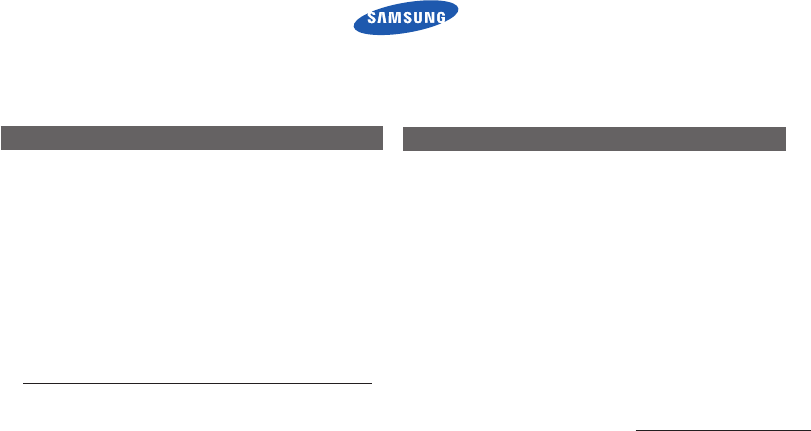
Declaration of Conformity
Product details
For the following
Product : DIGITAL CAMERA
Model : SAMSUNG NX1
Manufactured at:
Manufacturer: Samsung Electronics Co., Ltd
129, Samsung Ro, Yeongtong-gu, Suwon-si,
Gyeonggi-do, 443-742, Korea
Factory: TianJin Samsung Opto-Electronics Co., Ltd.
No.9 ZhangHeng Street, Micro-Electronic Industrial
Park, JinGang Road, Tianjin, China. 300385
(Factories name and address)
Declaration & Applicable standards
Hereby, Samsung Electronics Co., Ltd, declares that this digital camera
is in compliance with the essential requirments and other relevant
provisions of Directive 1999/5/EC and the DoC in the language of the
manufacturer.
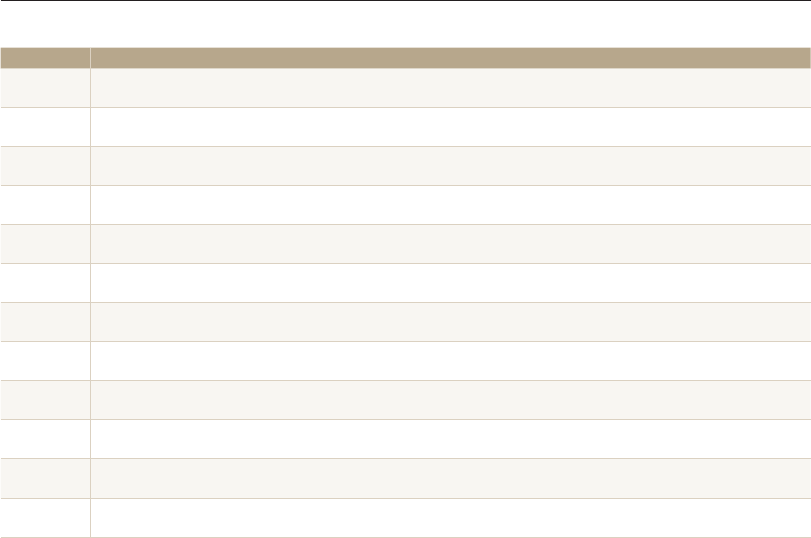
Declaration sentence in official languages
Nation Declaration
Cesky
SamsungElectronicstímtoprohlašuje,žetentodigitálnífotoaparátjeveshoděsezákladnímipožadavkyadalšími
příslušnýmiustanovenímisměrnice1999/5/ES.
Dansk SamsungElectronicserklærerherved,atdigitalekameraeroverholderdevæsentligekravogøvrigerelevantekravidirektiv1999/5/
EF.
Deutsch HiermiterklärtSamsungElectronic,dasssichdieDigitalkamerainÜbereinstimmungmitdengrundlegendenAnforderungenundden
übrigeneinschlägigenBestimmungenderRichtlinie1999/5/EGbendet.
Eesti KäesolevagakinnitabSamsungElectronicsdigitaalkaameravastavustdirektiivi1999/5/EÜpõhinõuetelejanimetatuddirektiivist
tulenevateleteisteleasjakohastelesätetele.
English Hereby, Samsung Electronics declares that this digital camera is in compliance with the essential requirements and other relevant
provisionsofDirective1999/5/EC.
Español PormediodelapresenteSamsungElectronicsdeclaraquelacámaradigitalcumpleconlosrequisitosesencialesycualesquiera
otras disposiciones aplicables o exigibles de la Directiva 1999/5/CE.
Ελληνική ΜΕΤΗΝΠΑΡΟΥΣΑηSamsungElectronicsΔΗΛΩΝΕΙΟΤΙηψηφιακήφωτογραφικήμηχανήΣΥΜΜΟΡΦΩΝΕΤΑΙΠΡΟΣΤΙΣ
ΟΥΣΙΩΔΕΙΣΑΠΑΙΤΗΣΕΙΣΚΑΙΤΙΣΛΟΙΠΕΣΣΧΕΤΙΚΕΣΔΙΑΤΑΞΕΙΣΤΗΣΟΔΗΓΙΑΣ1999/5/ΕΚ.
Français ParlaprésenteSamsungElectronicdéclarequel'appareilphotonumériqueestconformeauxexigencesessentiellesetauxautres
dispositions pertinentes de la directive 1999/5/CE.
Italiano ConlapresenteSamsungElectronicsdichiarachequestafotocameradigitaleèconformeairequisitiessenzialieallealtredisposizioni
stabilite dalla Direttiva 1999/5/CE.
Latviski AršoSamsungElectronicsdeklarē,kadigitālākameraatbilstDirektīvas1999/5/EKbūtiskajāmprasībāmuncitiemartosaistītajiem
noteikumiem.
Lietuvių ŠiuoSamsungElectronicsdeklaruoja,kadšisskaitmeninisfotoaparatas,atitinkaesminiusreikalavimusirkitas1999/5/EBDirektyvos
nuostatas.
Nederlands HierbijverklaartSamsungElectronicsdatdedigitalecamerainovereenstemmingismetdeessentiëleeisenendeandererelevante
bepalingenvanrichtlijn1999/5/EG.
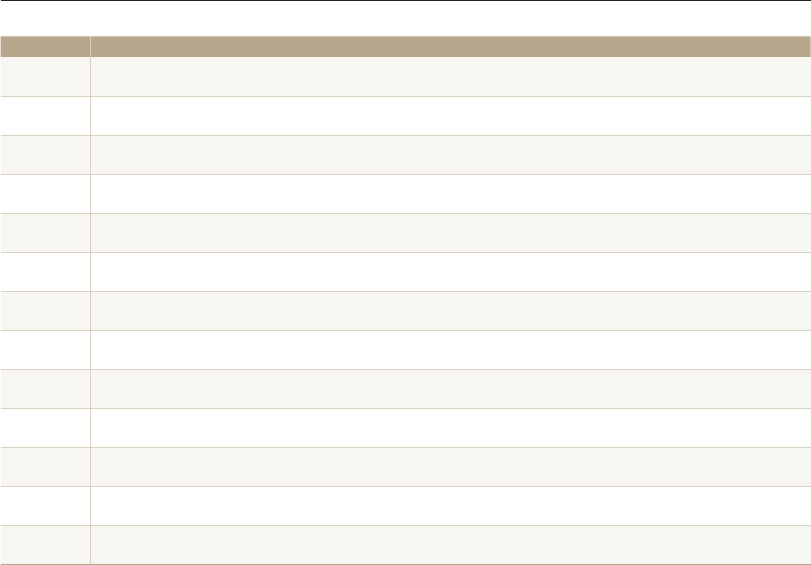
Declaration sentence in official languages
Nation Declaration
Malti Hawnhekk,SamsungElectronics,tiddikjaralidinil-kameradiġitalihikonformimar-rekwiżitiessenzjaliuma'dispożizzjonijietrilevanti
oħrajnta'Direttiva1999/5/KE.
Magyar ASamsungElectronicskijelenti,hogyezadigitálisfényképezőgépmegfelelaz1999/5/EKirányelvalapvetõkövetelményeinekés
egyébvonatkozóelõírásainak.
Polski NiniejszymrmaSamsungElectronicsoświadcza,żetenaparatcyfrowyjestzgodnyzzasadniczymiwymogamiorazpozostałymi
stosownymipostanowieniamiDyrektywy1999/5/WE.
Português SamsungElectronicsdeclaraqueestacâmeradigitalestáconformeosrequisitosessenciaiseoutrasdisposiçõesdaDirectiva
1999/5/CE.
Slovensko SamsungElectronicsizjavlja,dajetadigitalnifotoaparatvskladuzbistvenimizahtevamiinostalimirelevantnimidoločilidirektive
1999/5/ES.
Slovensky SamsungElectronicstýmtovyhlasuje,žetentodigitálnyfotoaparátspĺňazákladnépožiadavkyavšetkypríslušnéustanovenia
Smernice 1999/5/ES.
Suomi SamsungElectronicsvakuuttaatätenettätämädigitaalikameraondirektiivin1999/5/EYoleellistenvaatimustenjasitäkoskevien
direktiivinmuidenehtojenmukainen.
Svenska HärmedintygarSamsungElectronicsattdessadigitalkamerorståriöverensstämmelsemeddeväsentligaegenskapskravochövriga
relevantabestämmelsersomframgåravdirektiv1999/5/EG.
Български СнастоящотоSamsungElectronicsдекларира,четозицифровфотоапаратевсъответствиесъссъщественитеизискванияи
другитеприложимиразпоредбинаДиректива1999/5/ЕК.
Română Prinprezenta,SamsungElectronics,declarăcăaceastăcamerăfotodigitalăesteînconformitatecucerinţeleesenţialeşialte
prevederi relevante ale Directivei 1999/5/CE.
Norsk SamsungElectronicserklærerhervedatdettedigitalkameraeterisamsvarmeddegrunnleggendekravogøvrigerelevantekravi
direktiv1999/5/EF.
Türkiye Bubelgeile,SamsungElectronicsbudijitalkameranın1999/5/ECYönetmeliginintemelgerekliliklerineveilgilihükümlerineuygun
olduğunubeyaneder.
Íslenska HérmeðlýsirSamsungElectronicsþvíyraðþessistafrænamyndavélséísamræmiviðgrunnkröfurogönnurákvæðitilskipunar
1999/5/EB.
